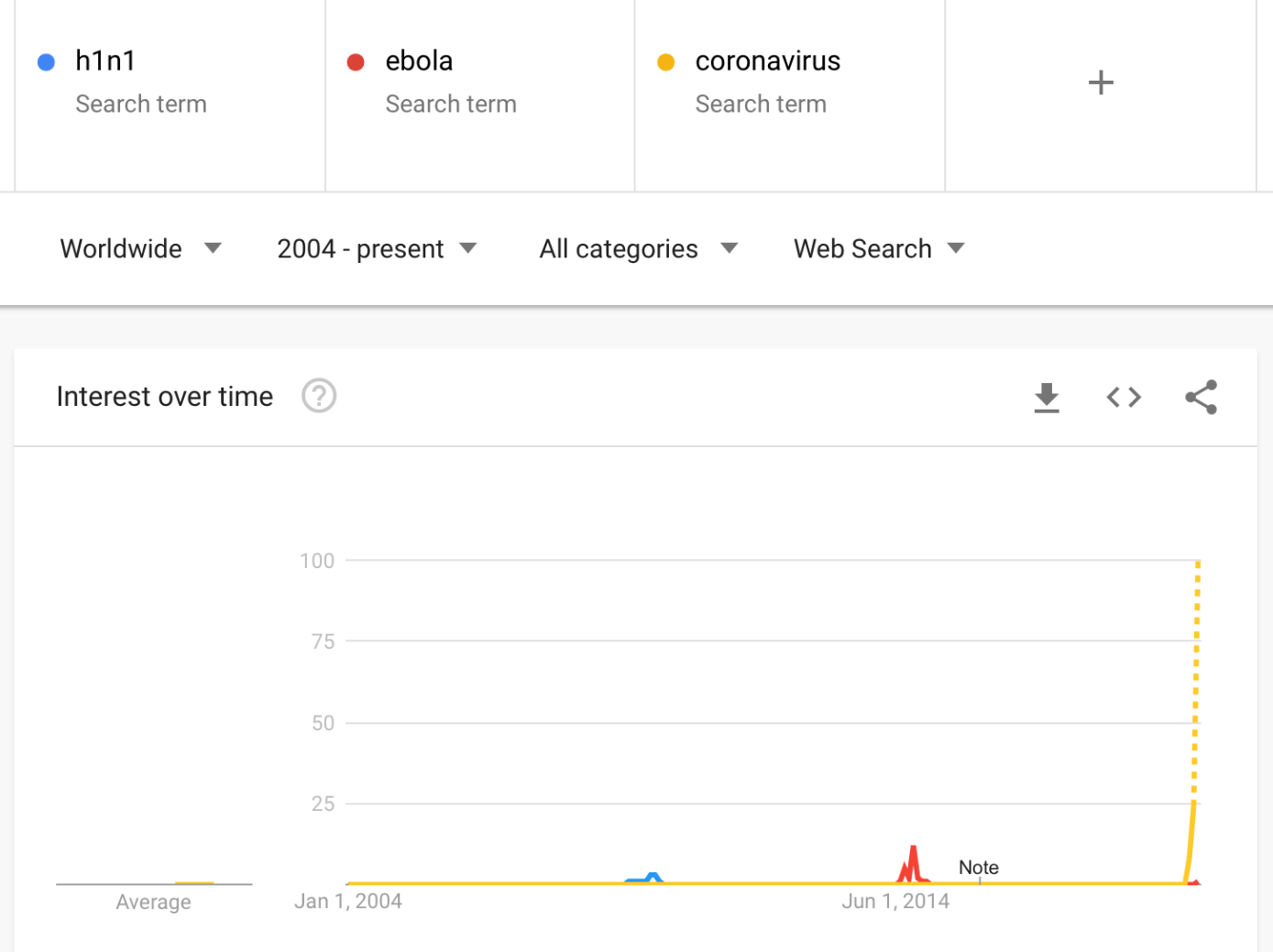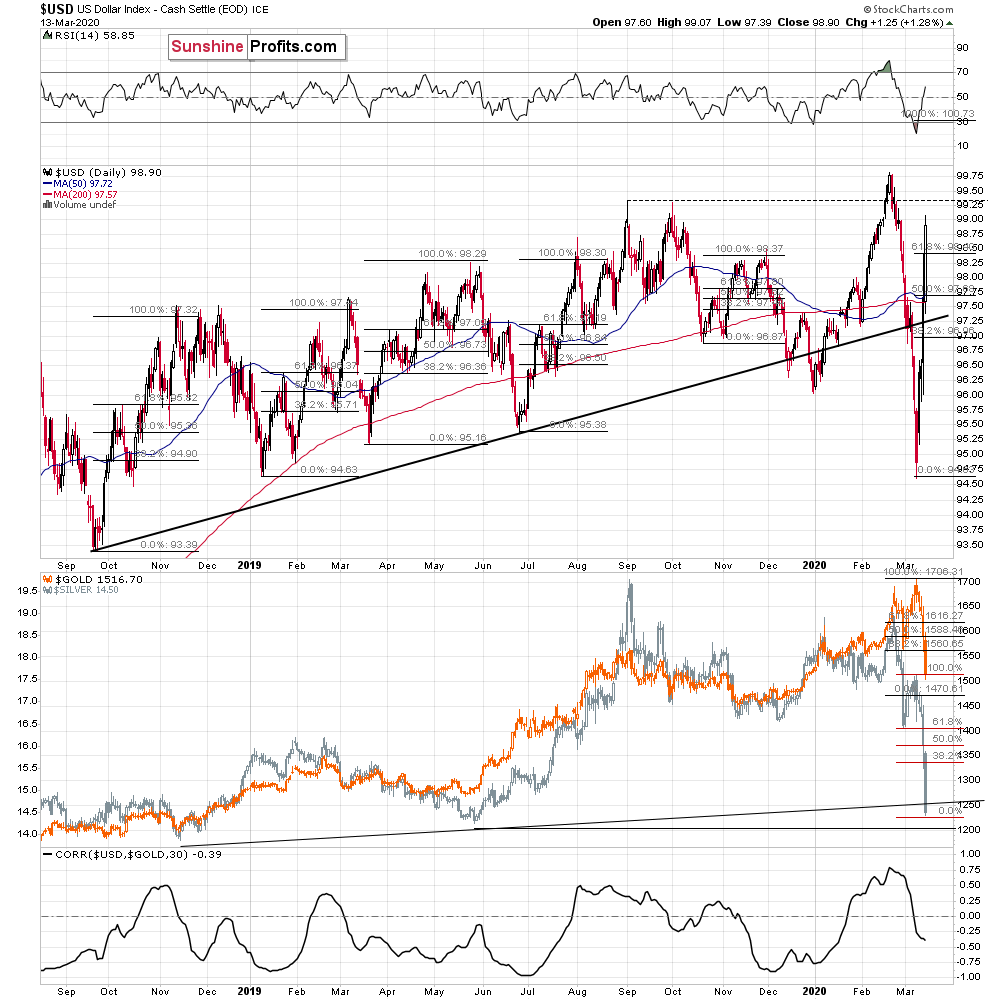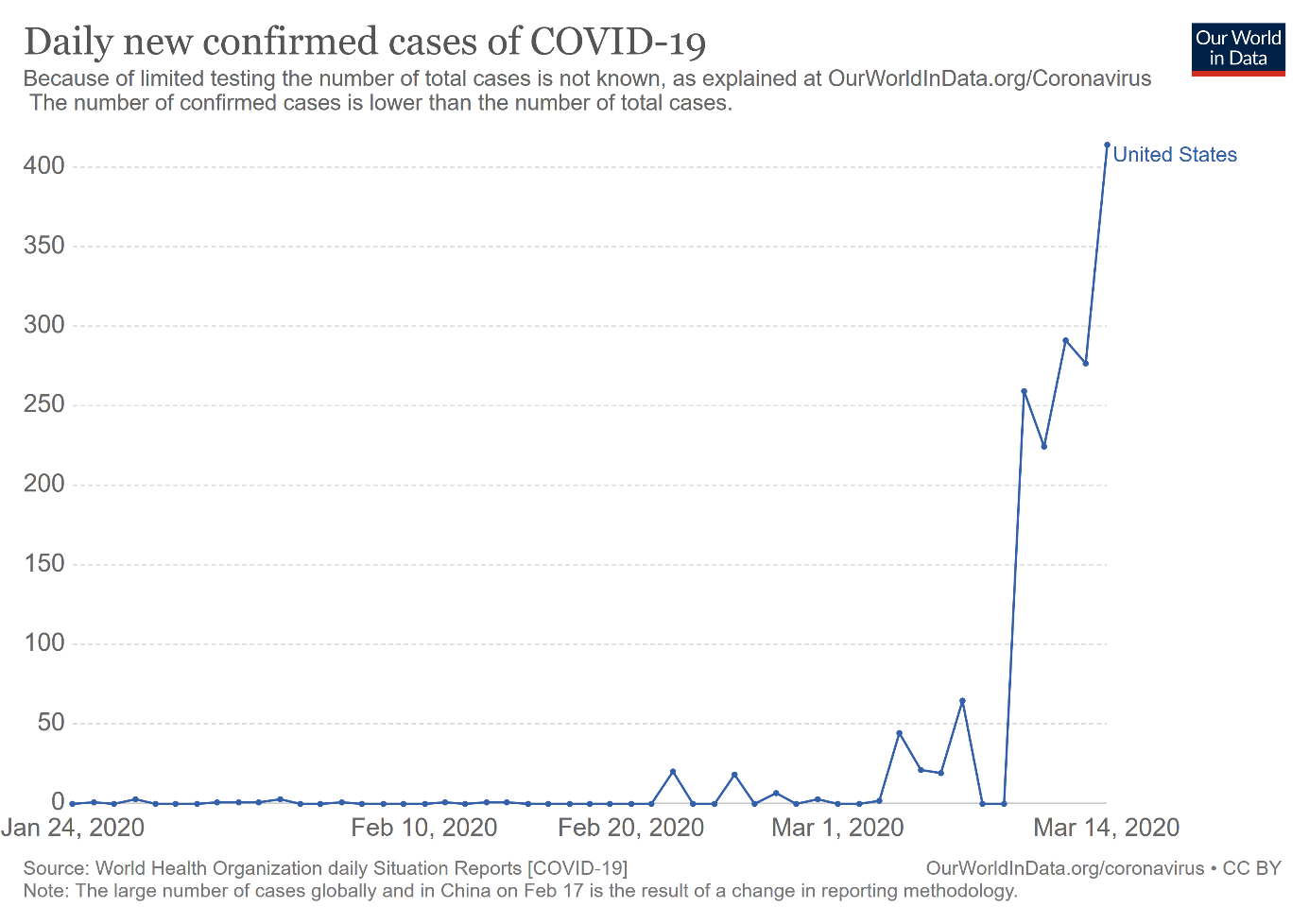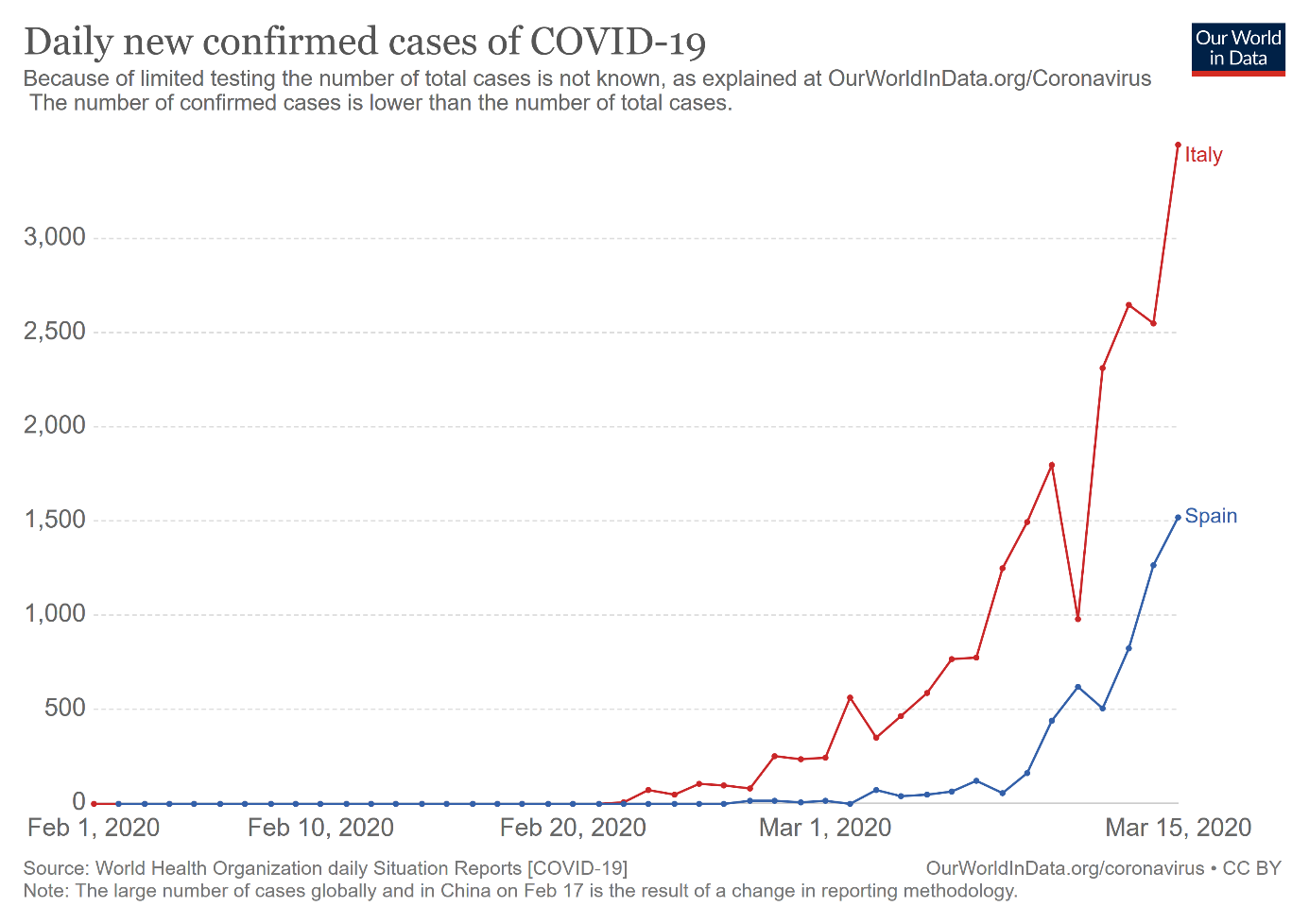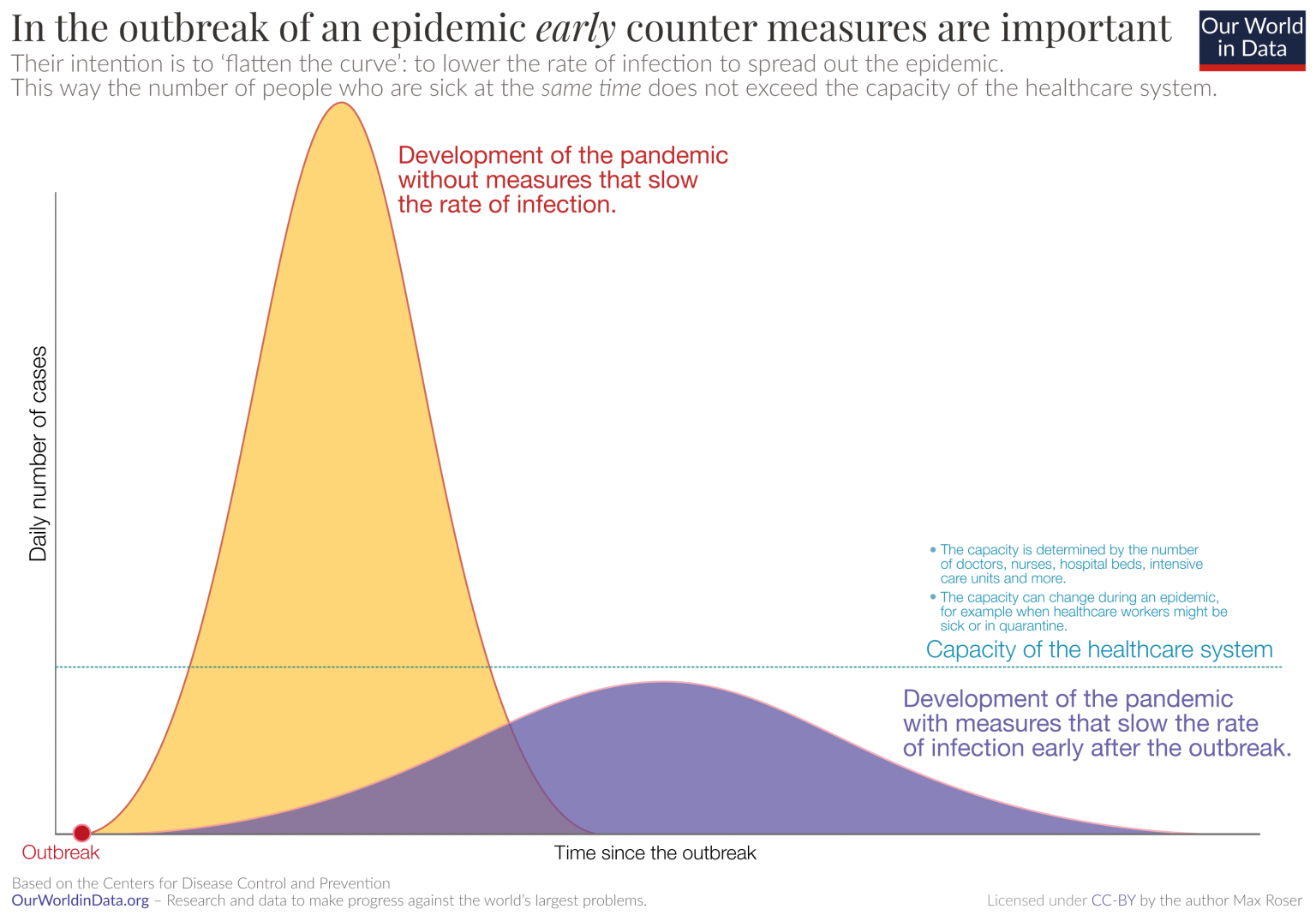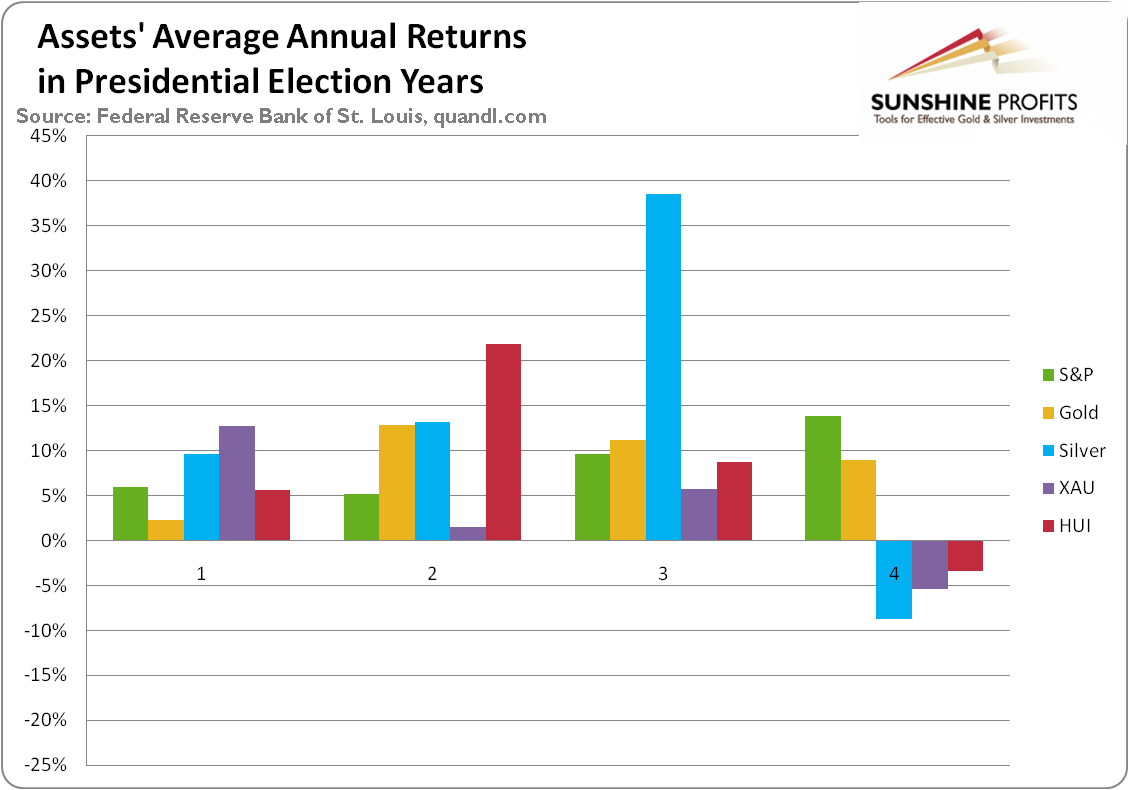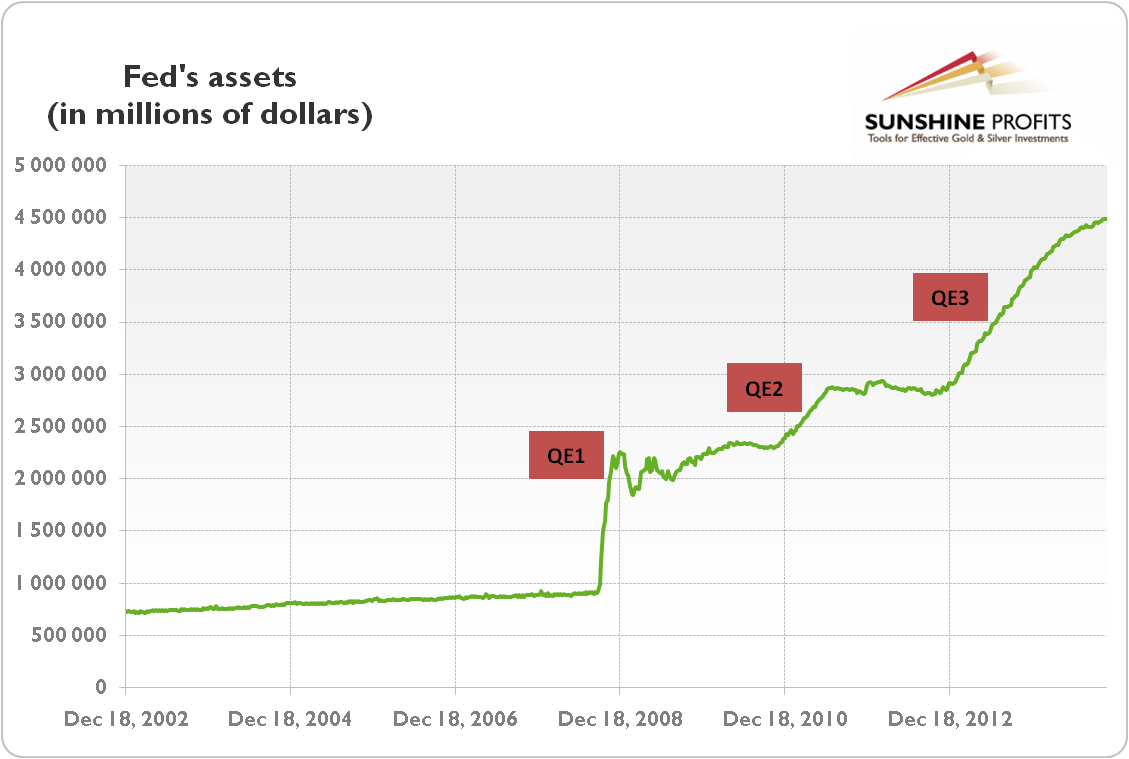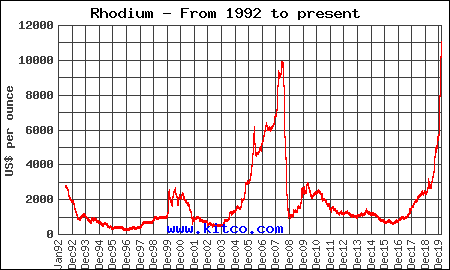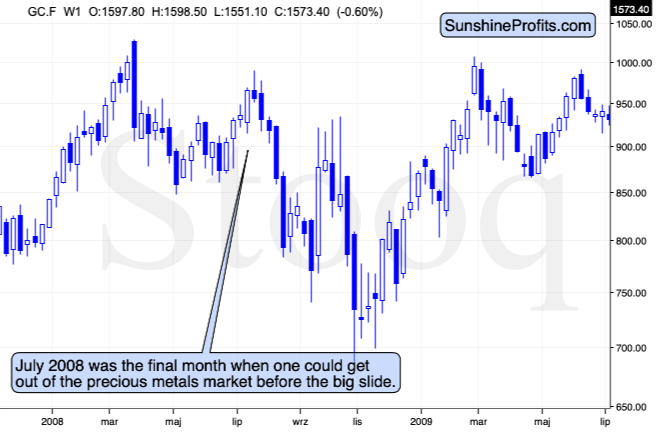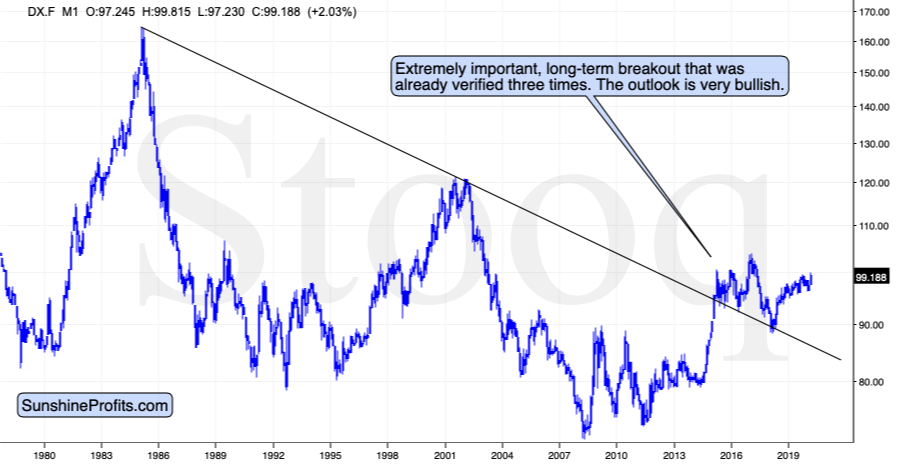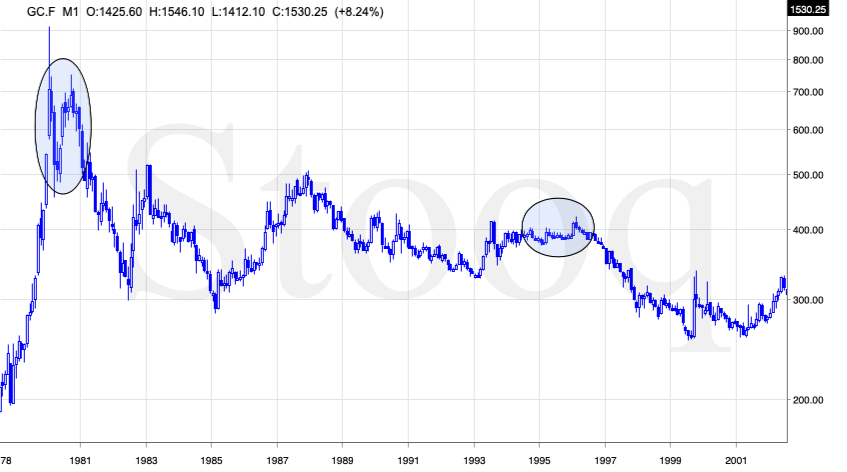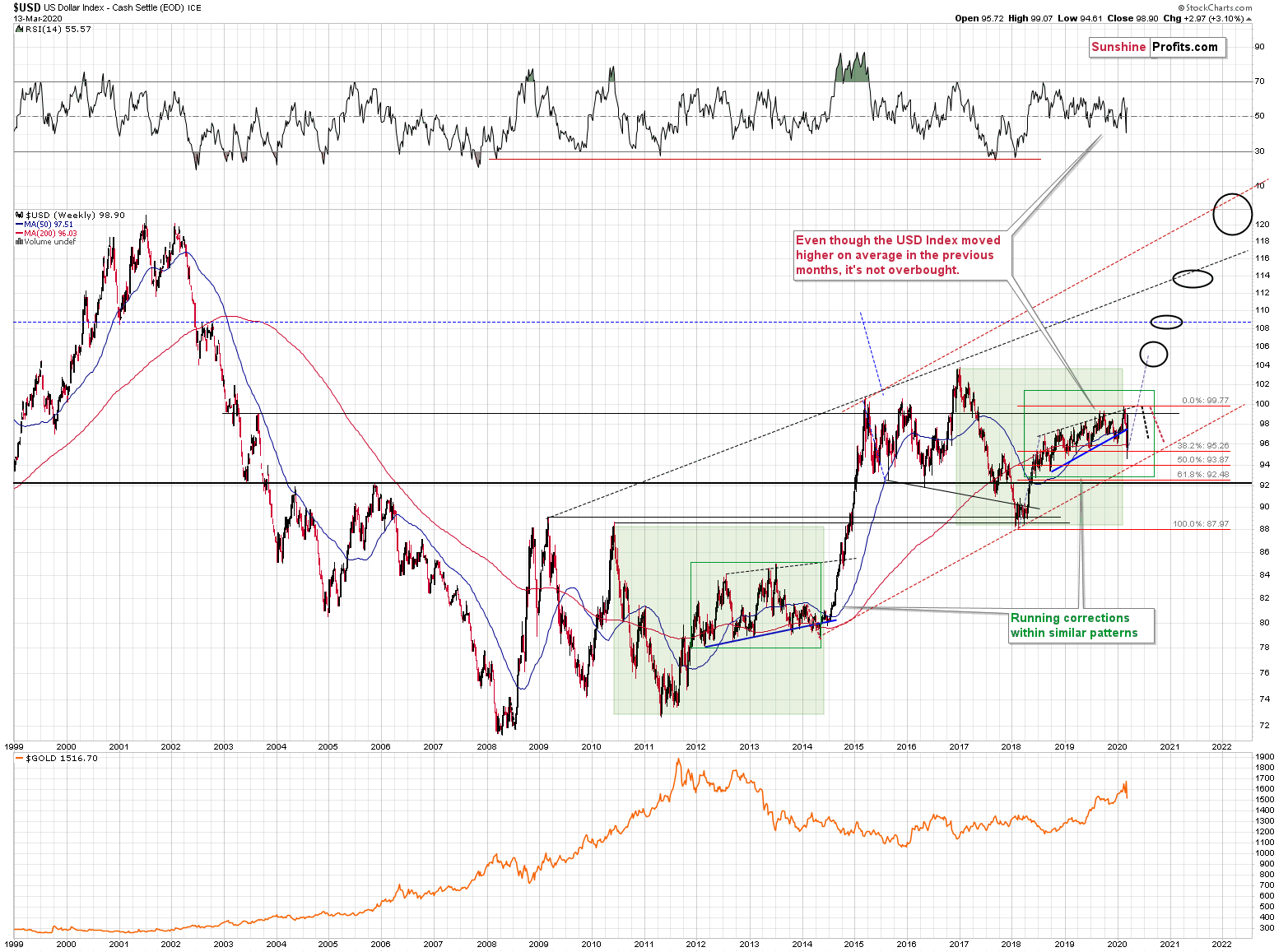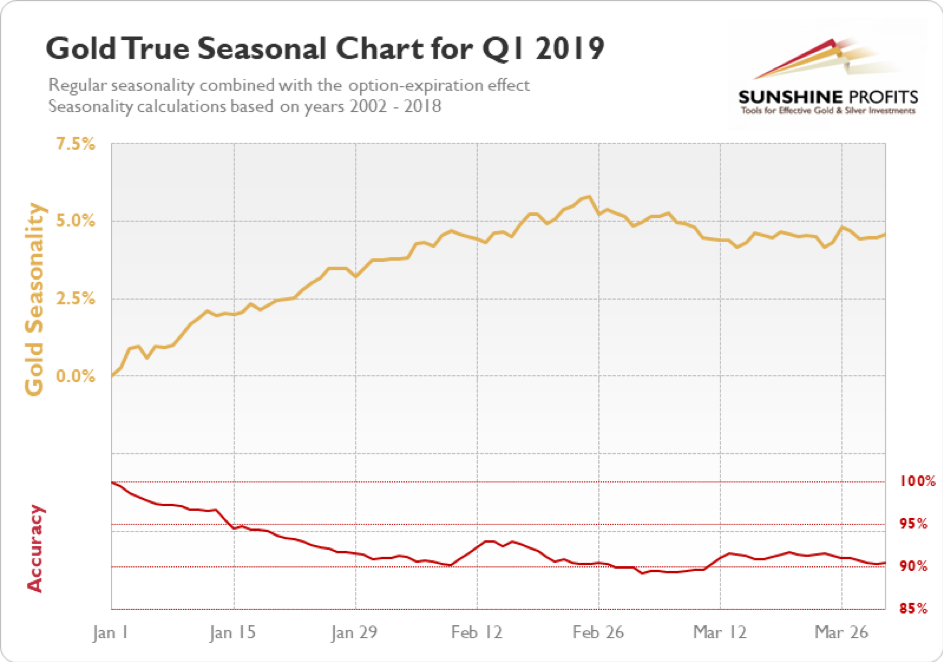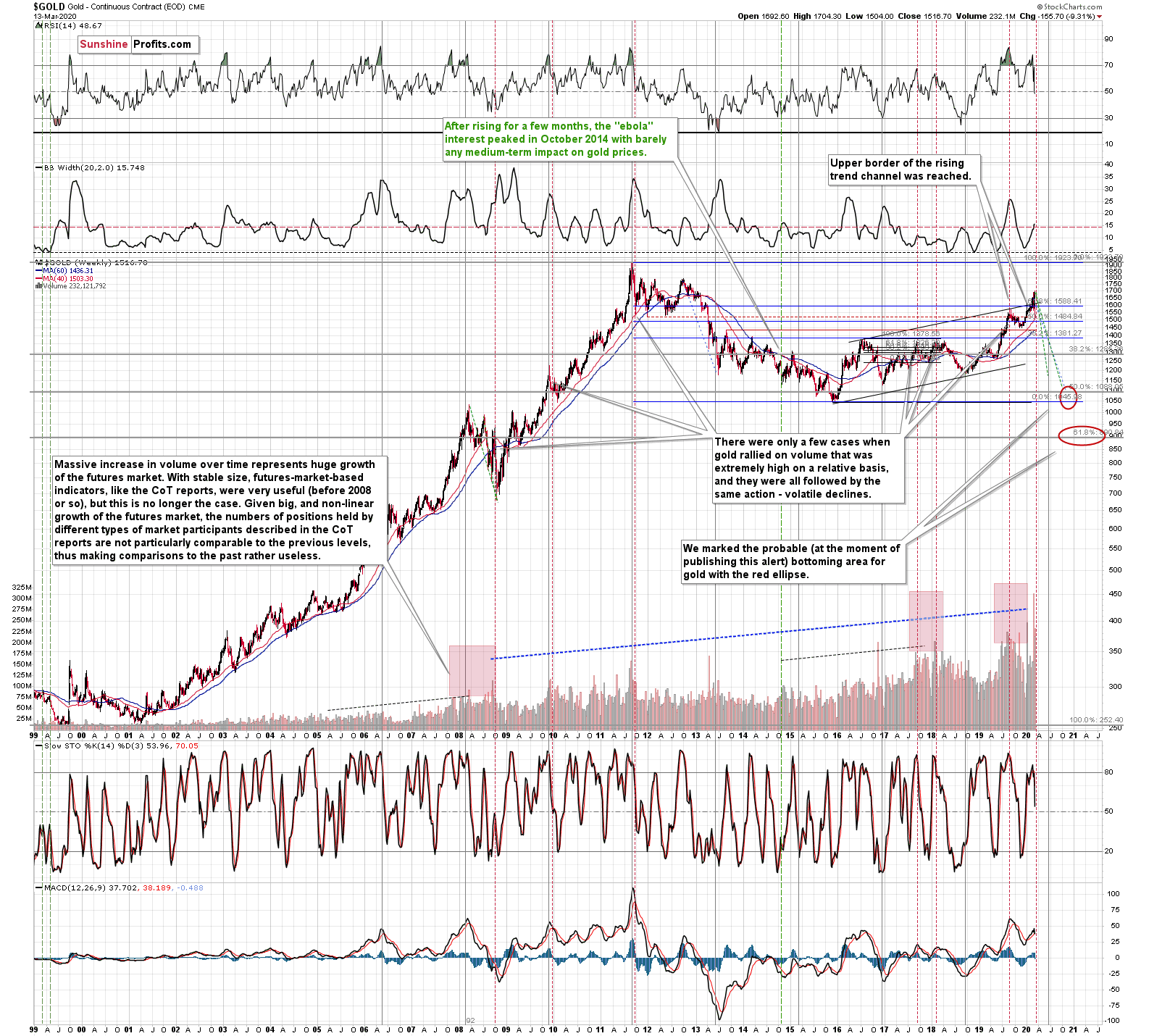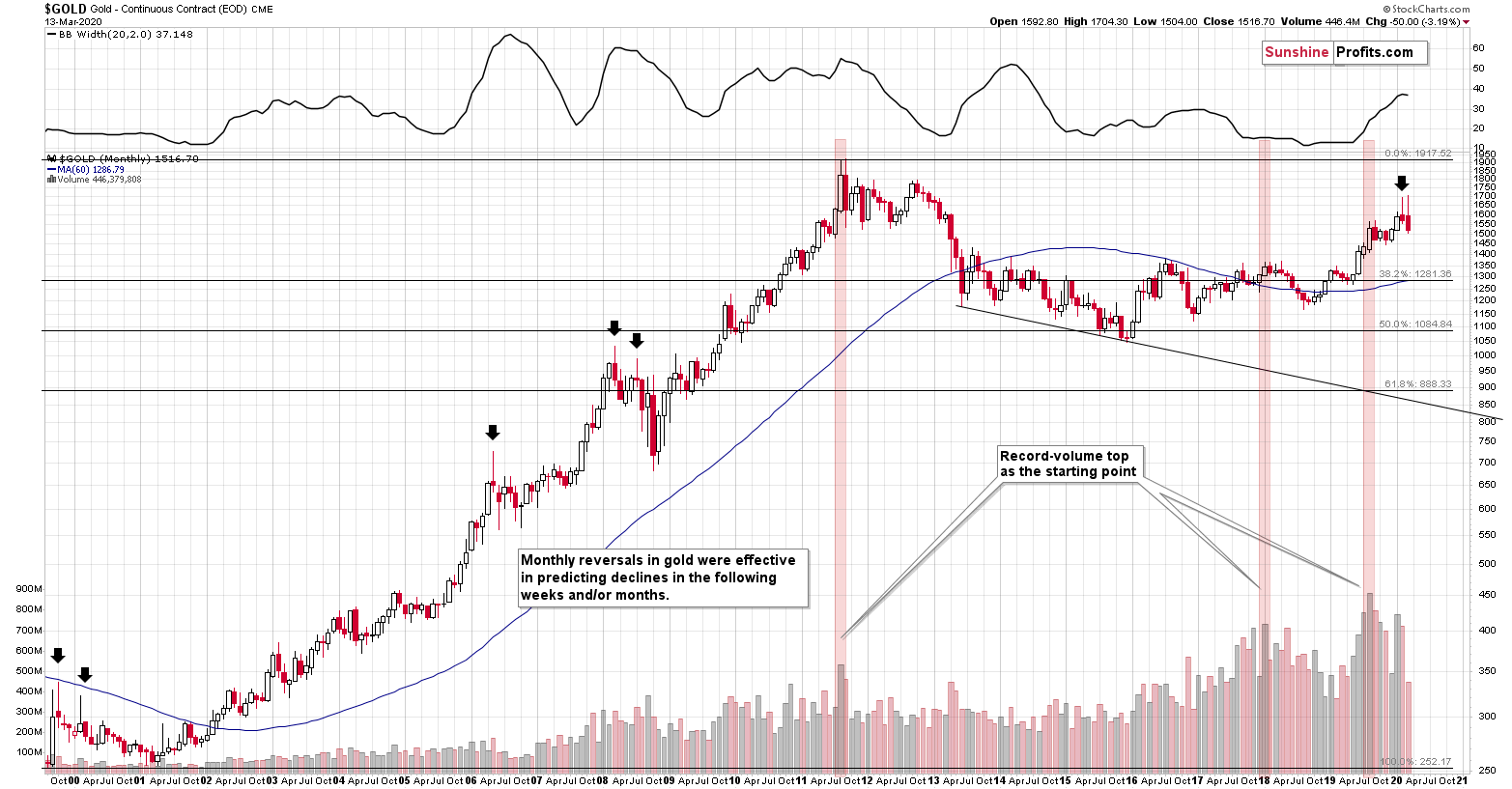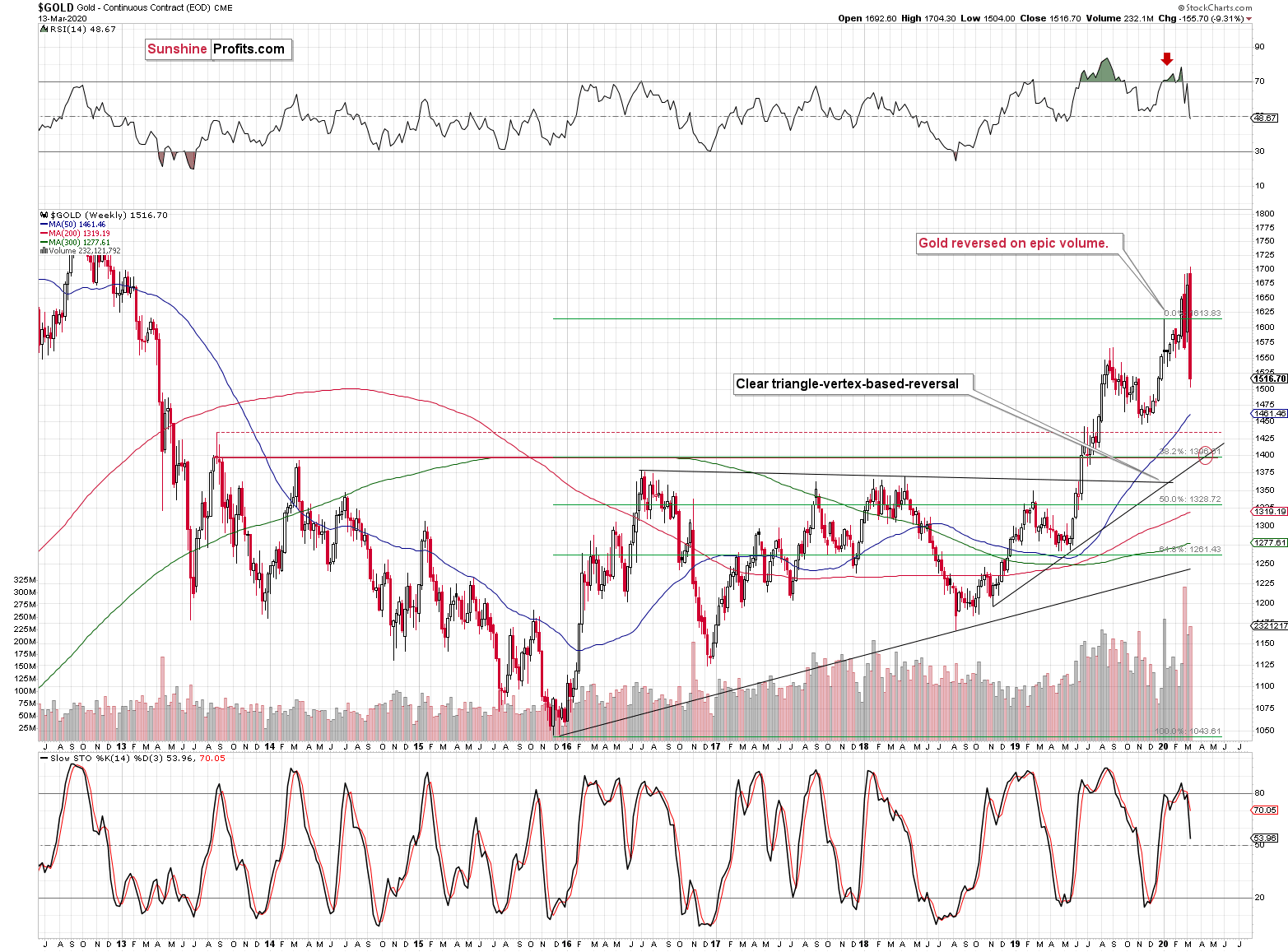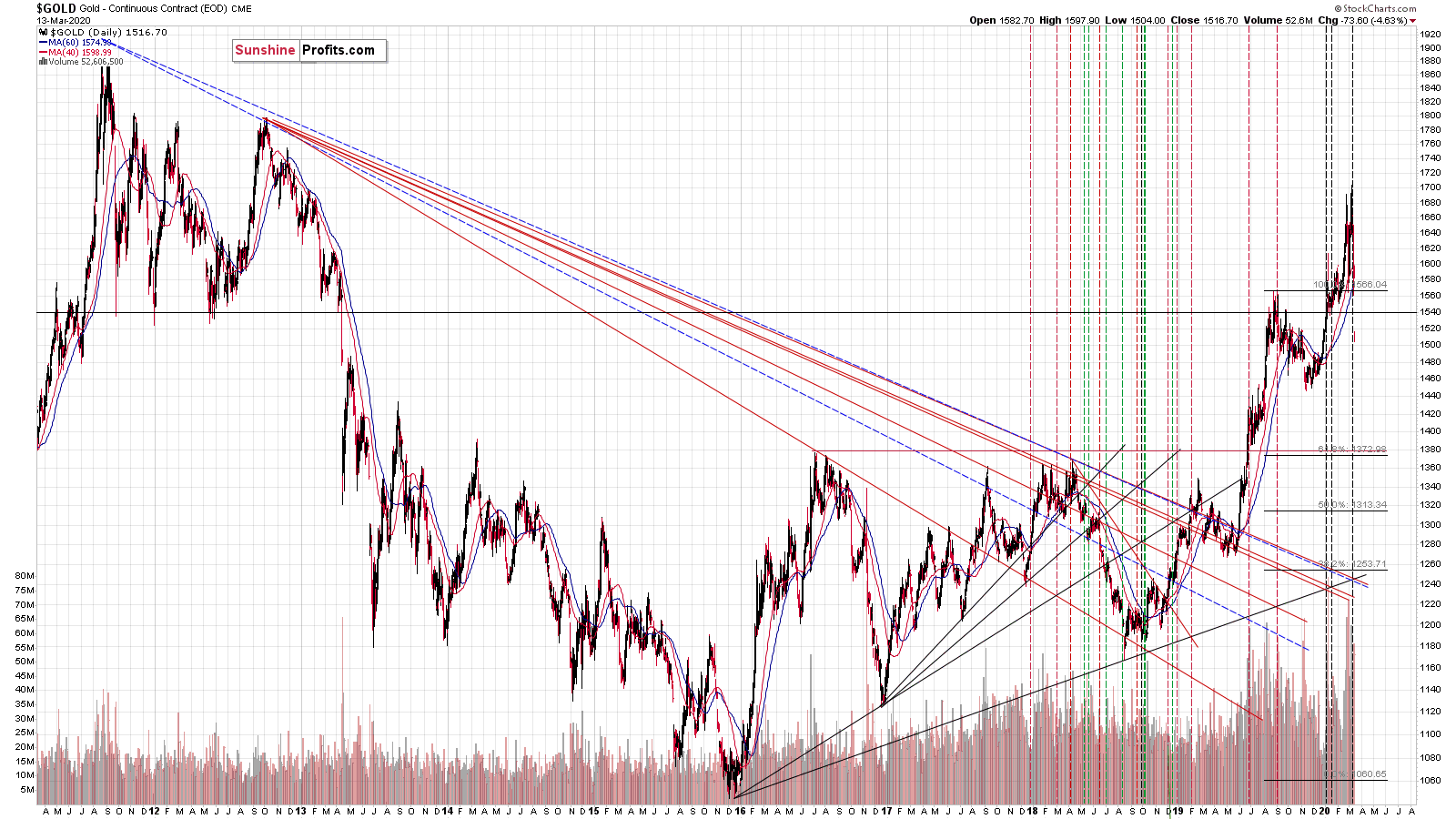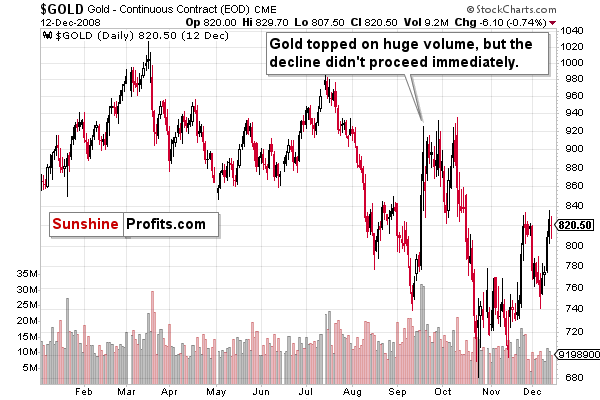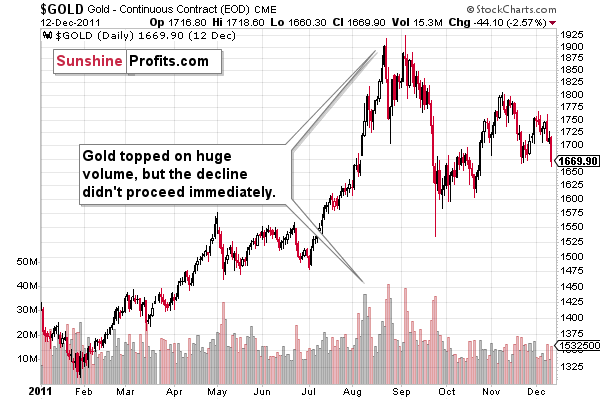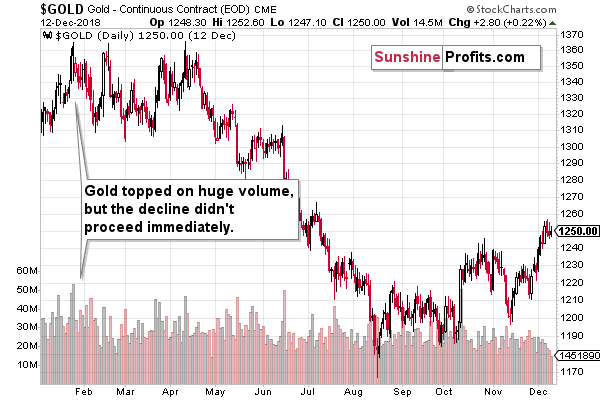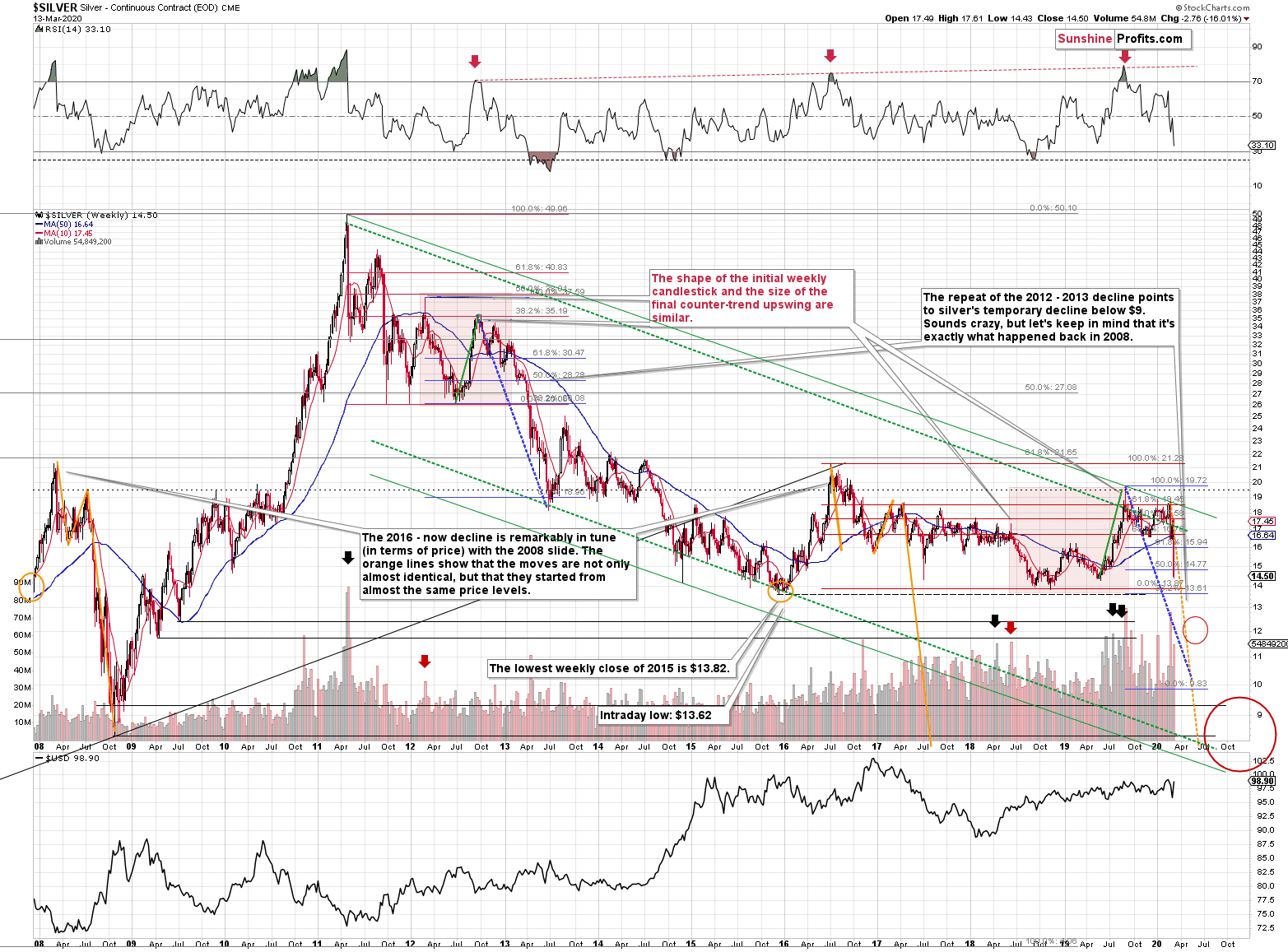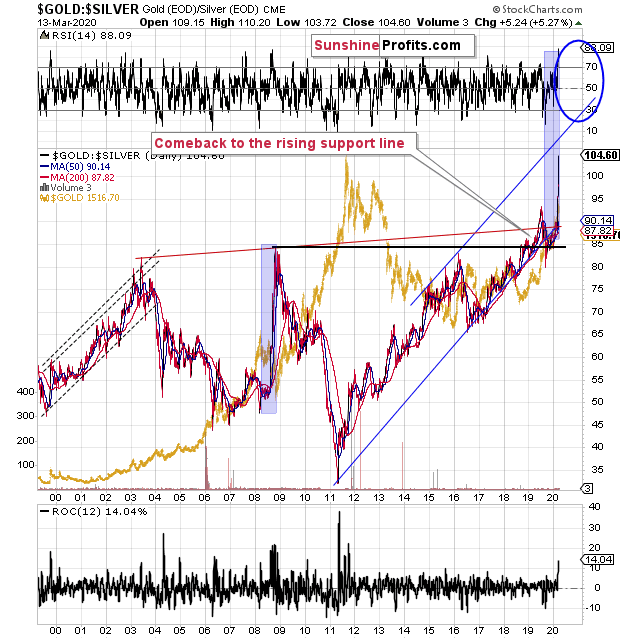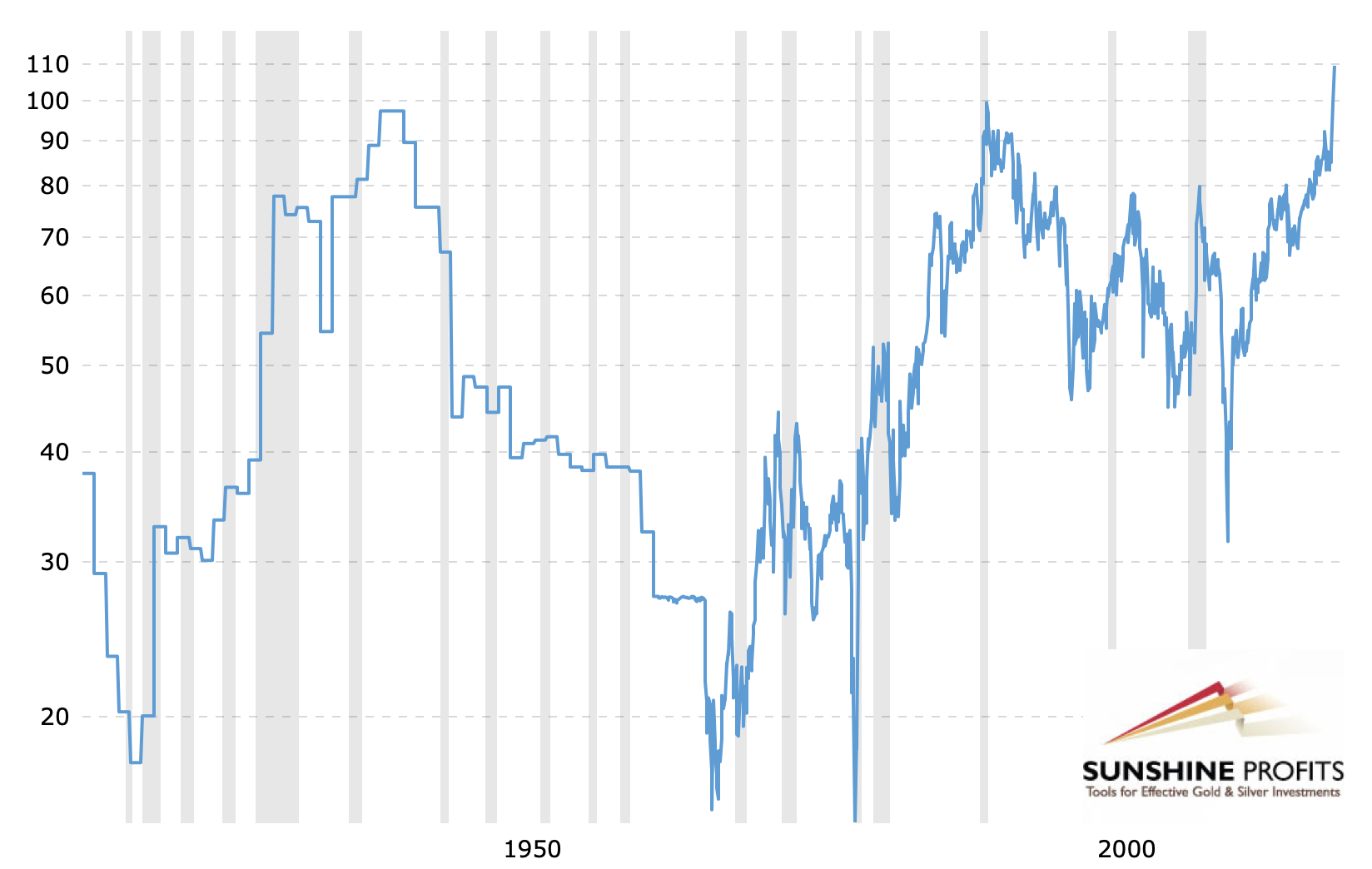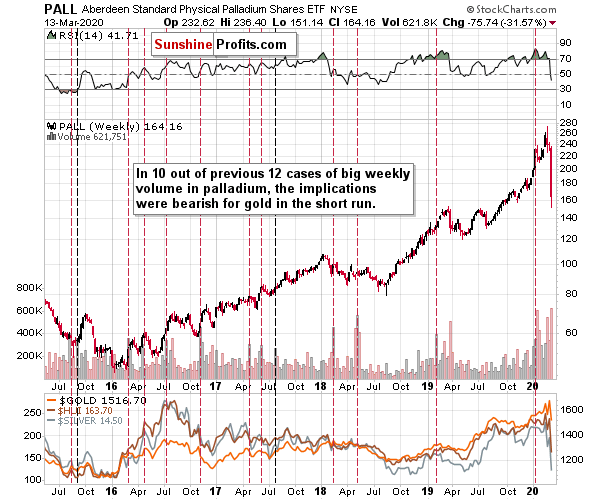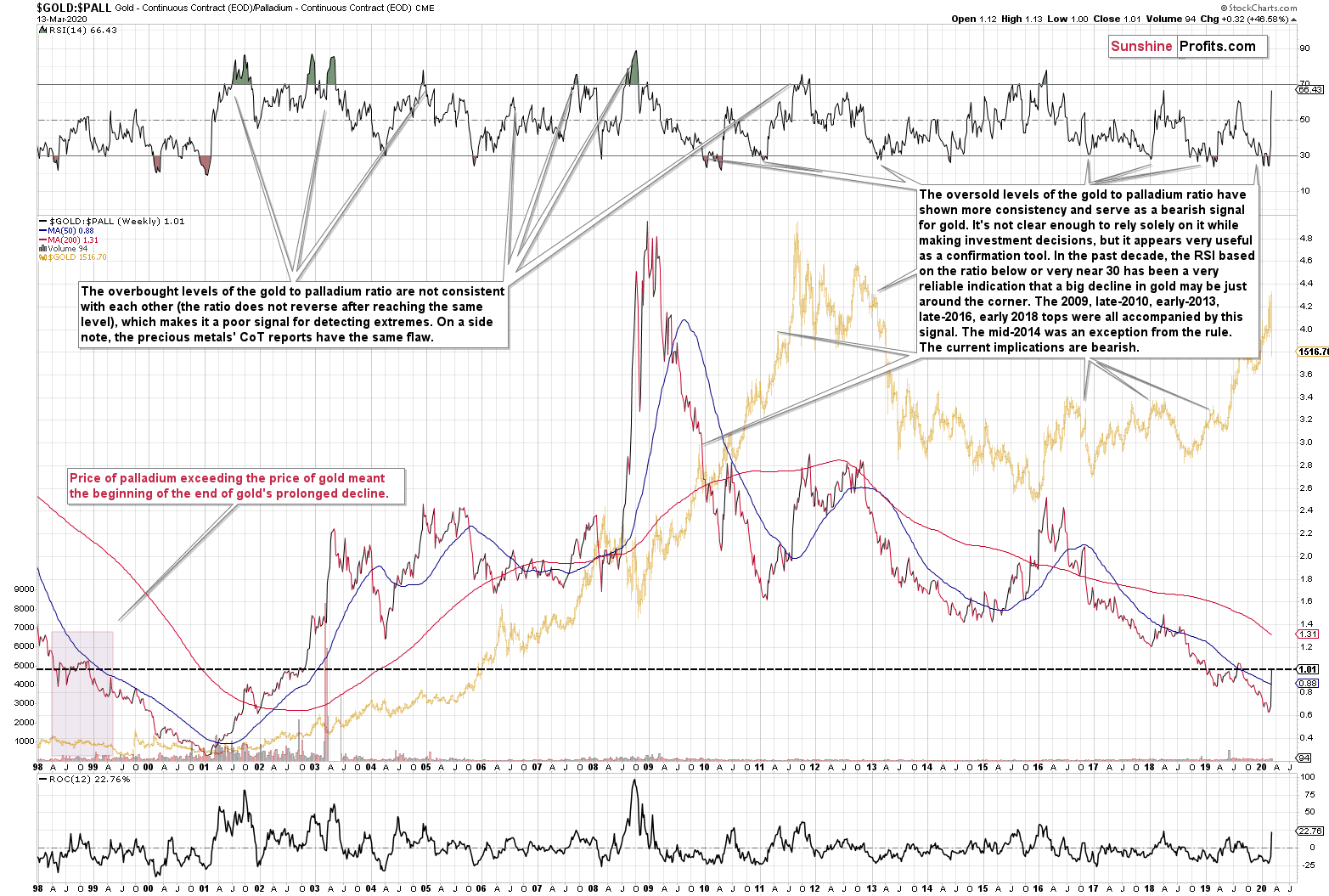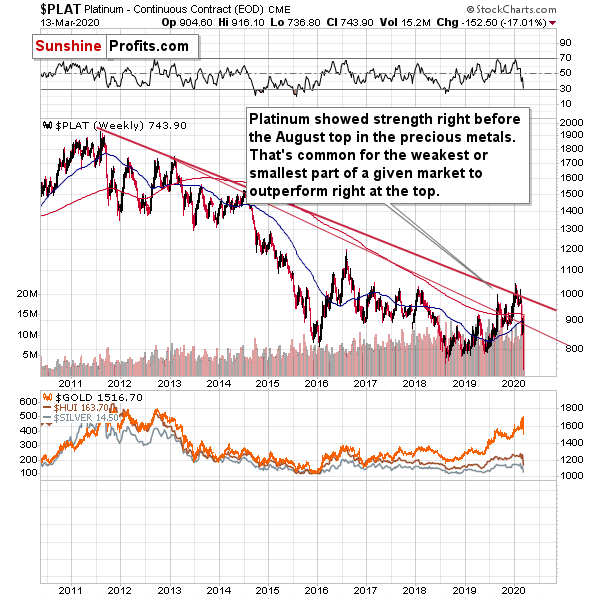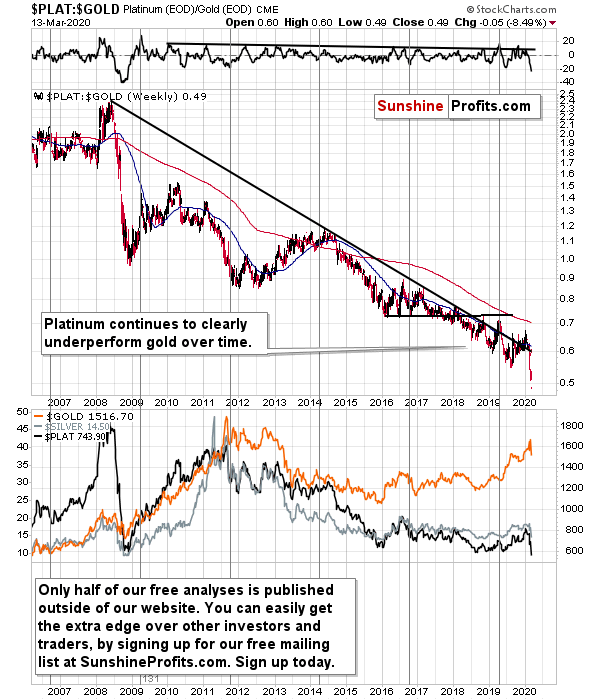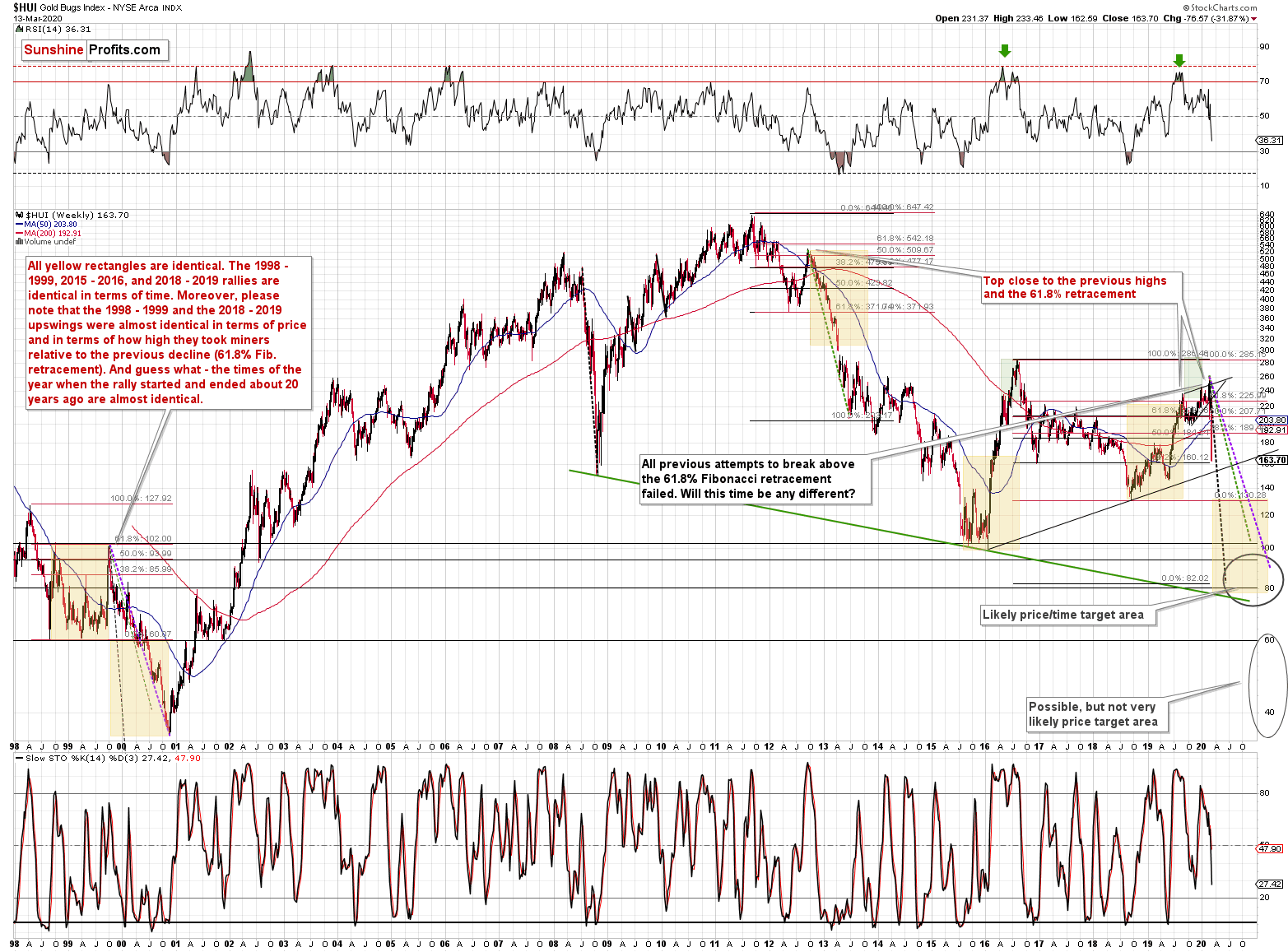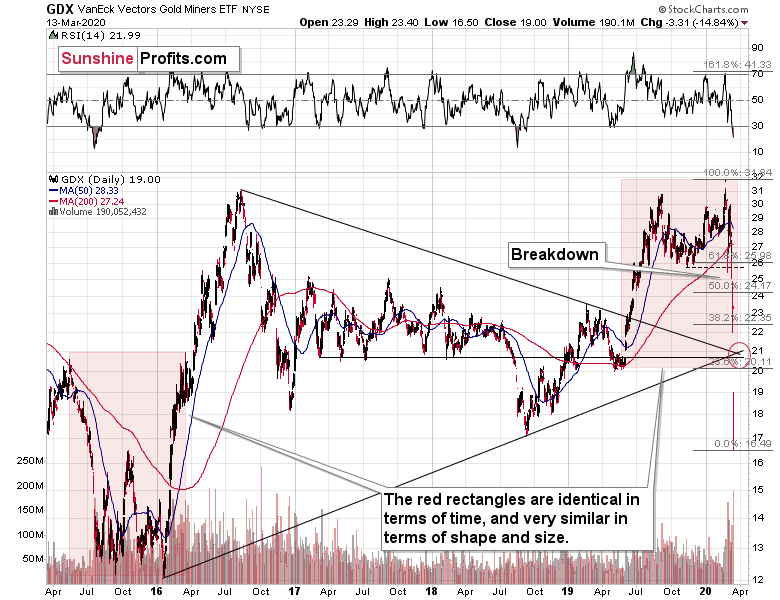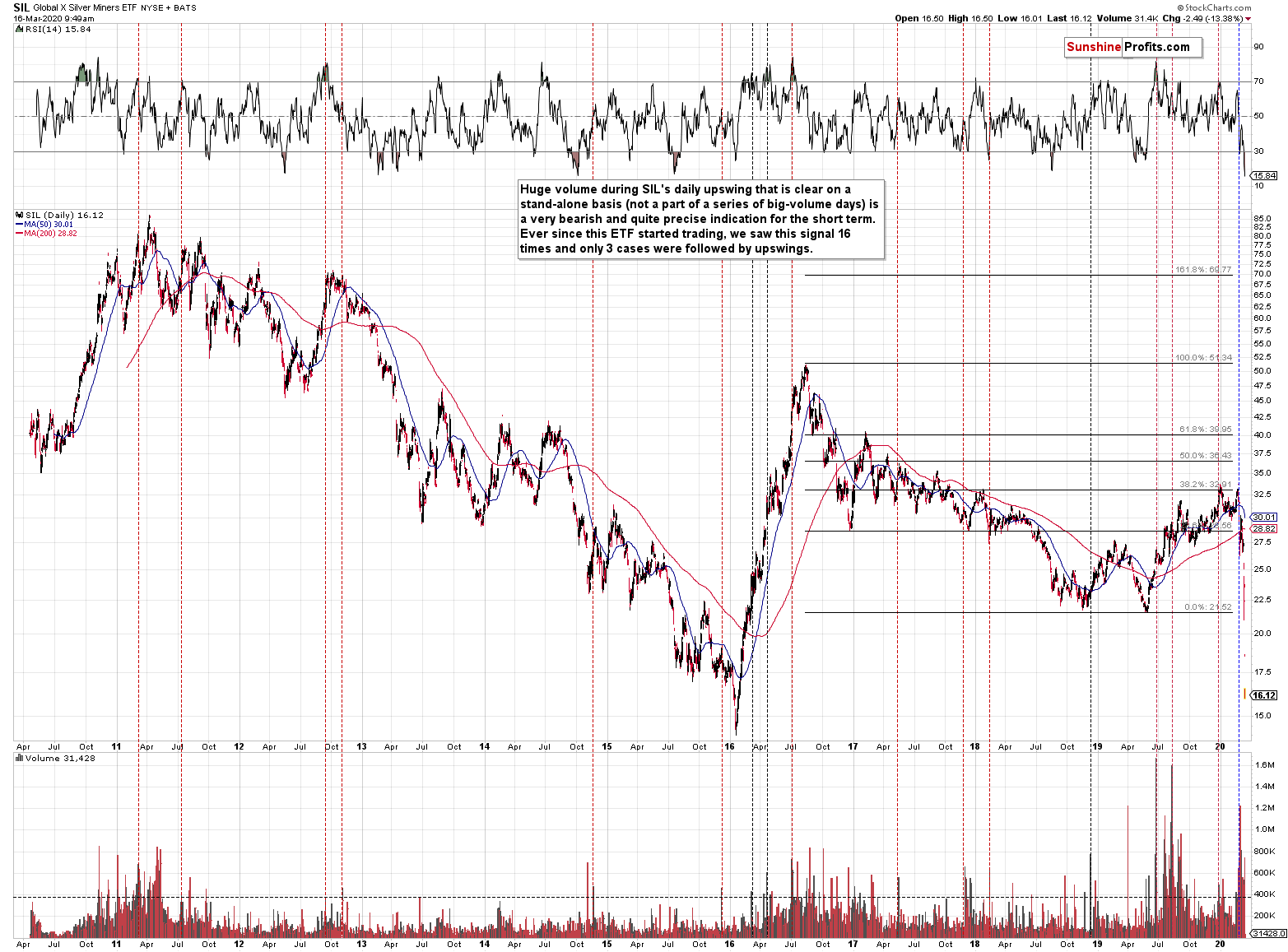Briefly: the outlook for the precious metals market is very bearish for the following months and weeks, but bullish for the following days (especially for the mining stocks).
Welcome to this week's Gold Investment Update.
Some of the most important analogies and long-term trends changed during the previous week but most of our previous extensive comments still remains up-to-date. In fact, the recent precious metals' and miners' breathtaking decline confirmed many of the points that we've been making. It also made our short positions (opened on February 21st) extremely profitable. We closed these positions and took profits on Friday.Of course, in today's analysis, we will update whatever needs to be updated or added. The parts that we didn't change (or changed only insignificantly) since last week, will be put in italics.
While we made tremendous amounts of profits last week, we have to admit that we underestimated the crisis that the fear of coronavirus fear would trigger. Given new facts and given the way monetary and political authorities react to them, we have to update our forecast, especially with regard to the aspect of fear.
We previously wrote that gold reacted to the coronavirus scare as it was likely to react - with declines that started after a short-term upswing. This was in tune with the way people reacted to the previous fears of viruses, in particular to the 2014 ebola scare.
BUT.
But it's much more than fear that has to be considered. Just like many (most?) people, we had assumed that the situation would be contained, and that it wouldn't spread outside of China, and if it did, than its impact would be relatively limited. This assumption turned out to be incorrect. The situation in the world is unlike anything we've seen in the last few decades. In terms of the total death count it's still not much more of a deal than regular flu, but the problem is that what we see right now it's just the very tip of the iceberg. An iceberg that is not only under water, but also almost entirely beyond horizon.
The fear of the virus went through the roof and is headed to the moon.
This implies a couple of things, and the most important one is that the analysis of what's likely to happen is increasingly more important compared to technical signals. Why? Because technical analysis is all about checking how things worked previously and assuming that most of the time history repeats itself to a considerable degree.
Sometimes, technicals alone trigger reversals and trends that then proceed based on technical rules.
Sometimes, fundamentals alone trigger reversal and trends that then proceed based on technical rules.
And sometimes, they both interact with each other in a yin-yang fashion creating a cocktail of triggers and psychological/technical mechanisms.
Right now we are in the third, most complex situation, with news being a very important trigger for the markets.
This means that the market analysis right now cannot focus only on technicals (except for day trading, of course, where it's perfectly justified), but has to deal with how the situation develops also in the real world.
The most similar situation to what we have right now from the medium-term point of view, is the 2008 decline, so it's our main point of reference.
Before discussing the analogies and similarities, let's consider how the situation is evolving and - most importantly - how the situation is likely to evolve going forward.
The Europe is on biological fire, at least its Western part. Countries are implementing various lockdown procedures, and some of them might actually manage to deal with the threat. The UK doesn't really do much in that regard, being an exception. The US is kind of in between both approaches - there are measures to counter the virus (and assertions of will to deal with it), but the actions seem relatively small compared to what measures were already implemented in Europe and Asia. This is the election year, and Trump really doesn't want to be the person who locked the country up and sent troops out on the streets to ensure that the lockdown is indeed enforced. He also refuses to take the responsibility for downplaying the virus threat for so long, and this sentence might be the key observation from this report. This is the case because a lot will depend on how Trump deals with the situation in the following days and weeks, and the above gives us a hint.
The hint is that there will be a lot of finger-pointing, some people will get fired, and there will be speeches about how the US is doing great overall, and that the virus is not really a big threat compared to other threats. Decisions will be made, but they will be made only after it is clear that the general (and voting) public wants those decisions. And they won't be dramatic. And the decisions will aim to ensure that it looks like the President is doing a great job (which might or might not be the case - the point is not to criticize the decisions that were not even made yet, the point is to see that the outside appearance of a given decision is and will be an important factor). These techniques to influence people and this approach overall tends to work under normal circumstances. But these are not normal circumstances.
Viruses care about very few things. They care about replication. They don't care about borders, politics, politicians, and egos. And they are not negotiating.
Before we move further, this would be a good time to quote what we wrote on Friday with regard to the USD Index and gold:
USDX and Gold
The USD Index soared back up as it became obvious that status of things in Europe is moving from bad to worse and that this is the way things are likely to remain for some time. After this "some time" we could see more selling pressure on the USD Index, which is unlikely to change the medium- or long-term uptrends in the US currency, but that are likely to cause short-term turbulences.
"Some time" here is directly related to how the situation regarding Covid-19 develops around the world. Now, it seems that the Europe and Asia are on fire, but things are relatively calm in the US.
If you have some time now, we encourage you to read this article on coronavirus - I find it to be the most informative piece on that topic that I've read so far (not in financial terms, but in general). If you don't have time right now, I strongly encourage you to get back to this article later today. Long story short, things are very far from ok in the US and unless some really dramatic measures are taken (some ideas are quite extreme), the virus will spread throughout the country. And we don't think that these measures will be taken in the US shortly, which is only likely to make things worse several days or weeks later.
Regardless of the way the situation is handled, it'll quite probably trigger further weakness in the US stock market. Still, the implications for the currency market are relatively unclear. Depending on how quickly the situation develops in various parts of the world, the currency exchange rates can behave differently.
It seems that the US is still in the very early stage of epidemic, while the Europe is in a comparatively latter one. This means that for some time (several days or more, but not as long as several weeks) people are likely to flock to the US dollar as a safe haven. However, once the US "catches up" with the rest of the world, or the situation gets worse as it is not dealt with soon enough, the situation could reverse as investors want to get out of the US dollar.
This might be when they turn to gold. They key word here is "might".
If that is about to happen, we should see some technical confirmations beforehand (not everyone will switch their preferences at the same time, so some things should be visible in the technicals).
It's very unclear how the coronavirus epidemic will be addressed in the US once it becomes much more severe. However, your Editor's best guesstimate is that the US will adopt the UK stance - to slow the disease's spread, but don't try to stop it, as it will be relatively unstoppable (using publicly acceptable means). Of course, we might be wrong, and it might be the case the charts tell us that before the implications hit the market in a big way.
For now, it seems that the USD Index is headed up. And this means that the prices of gold and silver are likely to move down.
In many previous cases, USD's initial rallies were then multiplied using the Fibonacci extensions. The way to check where the final short-term top is going to be, was to use the Fibonacci retracement tool and align the 61.8% retracement with the initial top. On the above chart, we applied that to previous rallies and this technique worked quite well. It's currently pointing to 100.73 as the next upside target.
Of course, that's above the recent 2020 highs and the 100 level which is a natural resistance as it's a round number. Round numbers tend to be important from the psychological point of view.
Any of these levels could stop USD's rally at least temporarily. Still, the 100.73 level appears to be the most likely target.
The key thing from the article to which we linked above is that there is a significant delay between when a person gets infected with coronavirus, to the moment when they finally get tested. Plus, most people who are infected don't have any visible symptoms, but are already spreading the virus. This means that the situation is currently exponentially more severe than its being reported. And it will get much more severe in the following days and weeks unless it is contained in a really decisive way.
It's unlikely that this decisiveness will come soon in the US. It will probably arrive when it's already too late, or it won't arrive at all as the problem is downplayed at the official level. The relatively easy measures will be taken - such as pumping money into the system, and so on. But that won't stop the virus. Really decisive actions would be required for that. The actions that are relatively unlikely to be seen in the US - at least not at the national level.
The mortality rate is between 0.5% and several percent, depending on how well prepared the health system is in a given country. Let's say that the mortality rate in the US will be 0.5%, which seems to be a conservative assumption. Given the delay in implementing decisive actions, a lot of people already are infected, and much more will become infected in the following days and weeks. Ultimately it could spread to, say 20% of the US population. And we're being conservative here - there are statistical models that point to about 50%-70% infection rate in the end.
With the US population at 327 million, this means that 327,000,000 * 20% * 0.5% = 327,000 Americans are likely to die from the Covid-19.
And what if the numbers were not that conservative? 1.5% mortality rate and 40% infection rate?
327,000,000 * 40% * 1.5% = 1.962 million Americans
Plus, many more millions worldwide.
It's not the point to predict the exact death toll number. The point is to show you how serious things are likely to get before this is all over.
Right now, there are only 3,244 confirmed cases of the novel coronavirus. The current death toll in the US is 61.
It's 61. And the death toll is going to increase exponentially until a major lockdown, which might never arrive. The death toll will not be counted in tens or hundreds. And not even thousands. And not tens of thousands. The best-case scenario that we see is that the death toll that is still below 100,000 in the US.
Now, the markets are forward-looking, so they should be discounting all the above right now. But they are not, as it's not intuitive for people to make such complicated calculations, especially that there are being reassured that everything is or will soon be under control. Ultimately people will act on emotions just as they did recently.
Now, the death toll in the US is "just" 61 and the stock market is already down over 20%, and there are signs of real estate market prices moving lower as people are unwilling to even watch new homes right now.
If people got scared out of their stock positions based on 61 deaths in the US and about 6000 deaths worldwide, then how bad can things go, when the death count is going to up in tens of thousands daily?
Extremely bad.
We expect things to get worse than they were in 2008. Of course, the question is how one defines "worse". Imagine what would happen if stocks dropped similarly as in 2008 but more and faster - and that's the likely scenario.
The problem with the 2008 slide was that it was relatively unpredictable, especially in case of gold. The corrective upswings were very fast and they didn't last for long. Overall, this kind of movement is also likely this time. The two parts of the precious metals market that were hit particularly strongly, were silver and mining stocks.
Last week miners declined more during the week, then they ever had previously - at least as long as the XAU Index exists. And in today's pre-market trading, silver just broke below the 2015 lows, finally confirming what we've been writing for years - the precious metals bear market didn't end in 2015 or 2016. It's 2008 all over again, but supercharged.
It might even be the case that the 1929 slide is a better analogy... But it's too early to say so.
Of course, even if the market is going to slide, it doesn't mean that it will slide without periodic corrections. Based on the analogy to the most similar week to the previous one (the one from July 2002 that we described in Friday's third Gold & Silver Trading Alert), it seems that the mining stocks are at or very close to such corrective upswing. Trading the upswings is difficult as they are likely to be sharp and very fast, which is why we focus on the easiest part of the move higher.
Right now, the death toll is still "relatively" low and the Fed just made a dramatic decision to cut rates over the weekend. Theoretically, the stock market should be rallying in the pre-market trading, but it declined instead. It could be the case that it will rally further during the day, but it too early to say. What we can say is that if a corrective upswing was likely to happen within the big slide (and that is the case), then it's likely to happen right now or shortly.
Let's get back to the big picture and think about the future. In several weeks, the situation in the US will probably be much worse than it is right now, a lot of people will die, and the stock market will already be trading much lower, likely taking precious metals sector with it (gold might be an exception, at least temporarily).
What then? Then the realization will come with regard to what really happened.
More or less (very rough approximate) as many people will die from the Covid-19 as they die from heart disease each year. People die due to many reasons and Covid-19 will increase the total death toll this year (say by 10% - 30% or so), but not multiply it in general. Those who die will be mostly retired seniors, and those who already had other diseases. As brutal and as harsh as it sounds (and we apologize for writing this, but still, it's our job to analyze the situation and report to you as we see it), this will be a huge personal loss, but not a huge economic loss for companies traded on the US exchanges. Almost everyone (in global terms) will still be around and companies will be able to operate as they had previously (for instance in 2019). The life will go on.
The buildings, the factories, the machinery - it will all still be there and there will be people, who are already immune to the Covid-19 disease that will be eager to get back to work full time (or overtime) and the central banks around the world will likely be providing support and cheap credit to get things up and running soon.
And people will realize that in the previous weeks - focused on deaths and their emotional aspect - they priced everything - stocks, commodities, real estate way too low. And a new bull market will start.
We have to get through many more individual tragedies, and through much more pain and panic in general before we get there. This means many more declines, especially for silver and mining stocks on the horizon.
Before I continue with my discussion of the situation, I would like to insert a few words from Arkadiusz Sieron, PhD. We will publish the following publicly tomorrow, but we want to share these thoughts with you earlier:
Fundamentally Speaking...
On Sunday, the Federal Reserve cut interest rates and restarted quantitative easing to stimulate economy hit by the pandemic of COVID-19. That's already its second move prior to this Wednesday's FOMC. What does it imply for gold?
It's Serious, Really.
Winter is not coming. Winter is here already. The situation does not look too good. Although the epidemic seems on the way out in China and South Korea, the situation in Europe and the US is deteriorating quickly. As you can see in the charts below, the new daily cases are quickly rising, making the total number of infected people doubling each 3-4 days. And please note that the chart shows only confirmed cases - the true number of infected people is almost certainly larger, especially in the US, where shockingly low number of tests have been conducted.
Chart 1: Daily new confirmed cases of COVID-19 in the US from January to March 14, 2020
Chart 2: Daily new confirmed cases of COVID-19 in Italy (red line) and Spain (blue line) from February to March 15, 2020:
Before I go on and analyze Fed's actions, I have to admit to while I was always concerned by the current epidemic as it leaped outside of China, I underestimated its health and economic impact. Surely, I'm not an epidemiologist and I wasn't the only one (think about the Italians, the White House or Spanish PMs' wife), but I should be smarter than the governments. It's of little comfort that the whole world and markets overlooked the danger for so many weeks, and we're all paying the price now.
One reason is that media are always panicking. Fear sells. They cry a wolf all the time, and when the true wolf comes, no one believes the boy that cried wolf too many times. Second reason was that when I analyzed the previous pandemics, such as SARS, MERS, or Ebola, they all were short-lived and their health and economic impact was limited. But, as I already suggested this likelihood, in one of the previous editions of the Fundamental Gold Report, this time is really different.
Why it is different? Well, it is because the new coronavirus is really smart. You see, Ebola was a stupid virus. It was very lethal, but it killed its hosts so quickly that it could not be with such ease transmitted to the others. MERS was not easily transmitted among people. And SARS was quickly contained because people transmitted the virus only well after they had symptoms. So, the authorities could easily track the infected people and isolate them. Problem solved. But the new coronavirus has a deadly combination of features. It is less lethal now than it was initially, and is more contagious. And people can transmit it before they have any symptoms. They can even have no symptoms at all!
All this means that containment is practically impossible. And comes with bringing the economic activity to a standstill. A very heavy price to pay. Let's face it. A high percentage of world's population will be infected. And many will die. We do not panic, but this is a fact. What we can done is to break its exponential trajectory, mitigate its impact and flatten the epidemiological curve, as the chart below shows.
Chart 3: The idea of flattening the curve.
In this way, we can slow the rate of infection to prevent the healthcare system from the total collapse. The good thing is that the mortality rate is generally low, especially among children and the young and healthy. But the problem is there are many people with health issues. A great percentage of Americans are obese and not too few are smoking - which worsens their situation. All this means that it's probable that the pandemic will not be a short-term issue we can quickly deal with, but that it will stay with us for months (I recommend this podcast with Micheal Osterholm, expert in infectious disease epidemiology, especially the first fifteen minutes)...
Ok, What Did the Fed Do?
On Sunday emergency meeting, the Fed slashed the federal funds rate to zero, or to almost zero, to be precise:
Consistent with its statutory mandate, the Committee seeks to foster maximum employment and price stability. The effects of the coronavirus will weigh on economic activity in the near term and pose risks to the economic outlook. In light of these developments, the Committee decided to lower the target range for the federal funds rate to 0 to 1/4 percent. The Committee expects to maintain this target range until it is confident that the economy has weathered recent events and is on track to achieve its maximum employment and price stability goals. This action will help support economic activity, strong labor market conditions, and inflation returning to the Committee's symmetric 2 percent objective.
Moreover, the US central bank has expanded its repo operations and reintroduced the quantitative easing:
The Federal Reserve is prepared to use its full range of tools to support the flow of credit to households and businesses and thereby promote its maximum employment and price stability goals. To support the smooth functioning of markets for Treasury securities and agency mortgage-backed securities that are central to the flow of credit to households and businesses, over coming months the Committee will increase its holdings of Treasury securities by at least $500 billion and its holdings of agency mortgage-backed securities by at least $200 billion. The Committee will also reinvest all principal payments from the Federal Reserve's holdings of agency debt and agency mortgage-backed securities in agency mortgage-backed securities. In addition, the Open Market Desk has recently expanded its overnight and term repurchase agreement operations. The Committee will continue to closely monitor market conditions and is prepared to adjust its plans as appropriate.
Will these actions help the economy? Now, they won't. Has the Fed's first cut helped to prevent the COVID-19 spread? No, it has not. If an entrepreneur cannot obtain the inputs badly needed for his factory, or if employees do not appear at work, the level of interest rates does not matter. Neither Powell, nor Lagarde, nor any other central bankers have any power to open production and service facilities closed due to quarantine or to push employees back to work, and consumers back to stores, cinemas, pubs and travel agencies.
Anyway, let's assume that the problem is related to the demand, not to the supply (as politicians and central bankers will probably argue). How should interest rate cuts help if people are encouraged to stay at home and, therefore, reduce economic activities? Which companies will start investing more in a period of reduced demand, supply chain disruptions, falling stock prices, and increased uncertainty in general?
Since ultra low interest rates did not help to revive exceptionally weak economic growth after the Great Recession, when coronavirus was still only among bats or pangolins, it will not help much now. Coronavirus affects the economy mainly by changing people's behavior - the actions of central banks will not change them. We deal with the healthcare crisis, not the liquidity crisis - so the extra liquidity will not help.
Implications for Gold
What does it all mean for the gold market? Well, panicked central banks reintroducing quantitative easing and ZIRP, combined with great fear and plunging stock markets, are fundamentally positive for the gold prices.
If so, why the heck the gold price has declined today below $1,500? That's a good question. As I said previously, cash is king in times of crisis. Investors desperately sell everything to raise cash to meet their margin calls. We see a replay from 2008 financial crisis, when the gold prices initially fell - but started to rally after a while. The epidemiology of COVID-19 suggest that this crisis will be larger than almost everyone initially thought. And the fact that the Fed acted in a panic mode just three days before the scheduled meeting suggests that we can expect really horrible data in the next few weeks. So, I think that the path of least resistance for gold has no option but is to rise in the medium term - the only question is when it will happen, and whether it will happen before a powerful emotional slide, like the one that we saw in 2008.
Arkadiusz Sieron, PhD
The US Presidential cycle is not as important as the above, but it's worth keeping it in mind, anyway.
Assets' Returns and Presidential Cycle
Average annual return of S&P (1948-2015, green line), gold (London P.M. Fix, 1972-2015, yellow line), silver (London Fix, 1972-2015, blue line), XAU Index (1984-2015, purple line) and HUI Index (1997-2015, red line) in presidential election cycles.
Gold's performance is more or less average in the election year, but in case of silver and mining stocks, we see something very different. Namely, the election year is the only year when - on average - they all decline.
So, does it mean that gold won't be affected by this specific cyclicality, but silver and miners will be? Not really. It seems that the above chart shows that silver and miners - on average - lead gold lower. They perform worst in the election year and the yellow metal is the worst choice in the following year - the first year of presidency.
Silver is already at new multi-year lows and miners just declined the most during the previous week...Ever. The above-mentioned analogy seems to have worked quite well.
We previously supplemented the above with the discussion of interest rates and QE4. We argued that the lower rates are not likely to help in a sustainable manner and neither will QE4. But we could see a temporary rally based on this factor.
Well, let's see what the previous quantitative easing programs did.
Quoting from our explanation of the link between QE and gold:
"The effects of quantitative easing on the gold market depended on how it was perceived by investors. Initially, after the financial crisis of 2008, quantitative easing was positive for the price of gold. It was a new and unprecedented program, which undermined the investors' confidence and caused a fear of inflation or even hyperinflation. However, the U.S. economy recovered after some time and there was no inflation on the horizon. In consequence, the price of gold entered a decline in September 2011, just two months after the end of the QE2. As the confidence in the Fed and the U.S. economy was restored, the third round of the quantitative easing was welcomed by the investors. The increased confidence reduced risk premia and the bidding for tail risk insurance. Consequently, the stock market rose, while the price of gold declined."
QE1 was very bullish for the precious metals sector - the market was surprised, and the precious metals market was already after a huge decline.
QE2 was still bullish for the PMs and miners, but not as much as the first round.
QE3 started in the final part of 2012 and as it continued, PMs and miners declined profoundly. QE3 didn't prevent the decline.
Each round of the QE program was less bullish than the previous one. This trend doesn't suggest placing a lot of bullish faith in QE4 with regard to the precious metals market.
The most bullish QE was the one that was launched after gold had already declined severely for months. This is definitely not the case right now. What is the case right now is that gold just declined tens of dollars despite the dovish change in investors' expectations toward interest rates. This suggest than neither rate cuts, nor QE4 may be able to stop the decline that just started - at least not on their own and not until gold drops much further.
One more thing regarding the elections. Trump is the anti-establishment President. Perhaps the "establishment" actually wants the stock market to tumble this year, to make sure that the next U.S. President will be pro-establishment. Consequently, perhaps the stock market won't be saved until it drops much lower, and until the U.S. dollar is soaring much higher, proving that pro-lower-dollar-Trump was unable to get what he aimed for.
Rhodium Update
Moving on to the technical part of today's analysis, let's take a look at rhodium. Practically everything we wrote on it last week remains up-to-date as rhodium declined significantly and invalidated its breakout above the $10,000 level, just as we had indicated previously. At the moment of writing these words, rhodium is trading at $7,500.
Quoting our previous analysis:
Many people never heard of it and it's hardly a surprise. You know that palladium and platinum markets are tiny compared to silver, which in turn, is small compared to gold's market. Well, rhodium's market is about a tenth of the size of palladium or platinum. Rhodium isn't traded on exchanges and the market for coins and bars is very, very small. Rhodium is mined as a byproduct of platinum and nickel and its mainly used in autocatalysts. There are other applications as well (Swarovski jewelry is often rhodium-plated for instance).
The most interesting thing about rhodium is how much it rallied recently.
This month, without a major shift in its supply or demand, rhodium soared to its new all-time high above $10,000, greatly outperforming other precious metals and almost every other asset. It's not very far above its July 2008 high, so rhodium prices are very vulnerable to a sudden selloff. The situation will become bearish only after the breakout to new highs is invalidated, but given the parabolic nature of rhodium's rally, the move higher looks very unsustainable.
The drop that followed the 2008 top was extremely sharp so everyone invested in rhodium right now might want to consider moving their capital somewhere else.
The demand coming from Asia is big, but this doesn't justify the near-vertical price rally. This demand wasn't absent just a year ago and yet rhodium was not skyrocketing as it is right now. Rhodium seems to be in a price bubble that's likely to pop.
There are very interesting implications for the precious metals market in general as well. You see, the tiny and most volatile parts of a given market tend to behave very specifically. Juniors, for instance, tend to outperform senior mining stocks in the final parts of upswings. Rhodium, being the tiny part of the PM market, could be showing us that what we see in the precious metals marker right now, is a medium-term top.
That's the theory, but did this theory work in 2008, when rhodium topped?
You bet it did.
Rhodium topped in July, 2008 and that was when gold formed the final high before one of the sharpest and biggest plunges of the past decades. In case of silver and mining stocks, it was the beginning of THE sharpest decline of the recent decades.
There are very few analogies that could be more bearish than the one that rhodium is now featuring.
Actually, given the fact that volume on which the 2008 top formed and volume on which gold topped recently are relatively similar (gold volume spiked in both cases), the above analogy is confirmed. Additional confirmation comes from the fact that in both: 2008 and 2020, gold tried to rally to the previous highs, and failed to reach them. In 2008, rhodium soared during this second attempt, and this is exactly the case right now. The analogy is clear and extremely bearish.
The Big Picture View of the USD Index
(please click on the charts to enlarge them)
The 2014-2015 rally caused the USD Index to break above the declining very-long-term resistance line, which was verified as support three times. This is a textbook example of a breakout and we can't stress enough how important it is.
The most notable verification was the final one that we saw in 2018. Since the 2018 bottom, the USD Index is moving higher and the consolidation that it's been in for about a year now is just a pause after the very initial part of the likely massive rally that's coming.
If even the Fed and the U.S. President can't make the USD Index decline for long, just imagine how powerful the bulls really are here. The rally is likely to be huge and the short-term (here: several-month long) consolidation may already be over.
There are two cases on the above chart when the USD Index was just starting its massive rallies: in the early 1980s and in mid-90s. What happened in gold at that time?
Gold Performance When the USD Index Soars
These were the starting points of gold's most important declines of the past decades. The second example is much more in tune with the current situation as that's when gold was after years of prolonged consolidation. The early 1980s better compare to what happened after the 2011 top.
Please note that just as what we saw earlier this year, gold initially showed some strength - in February 1996 - by rallying a bit above the previous highs. The USD Index bottomed in April 1995, so there was almost a yearly delay in gold's reaction. But in the end, the USD - gold relationship worked as expected anyway.
The USD's most recent long-term bottom formed in February 2018 and gold seems to have topped right now. This time, it's a bit more than a year of delay, but it's unreasonable to expect just one situation to be repeated to the letter given different economic and geopolitical environments. The situations are not likely to be identical, but they are likely to be similar - and they indeed are.
What happened after the February 1995 top? Gold declined and kept on declining until reaching the final bottom. Only after this bottom was reached, a new powerful bull market started.
Please note that the pace at which gold declined initially after the top - in the first few months - was nothing to call home about. However, after the initial few months, gold's decline visibly accelerated.
Let's compare the sizes of the rallies in the USDX and declines in gold. In the early 80s, the USDX has almost doubled in value, while gold's value was divided by the factor of 3. In the mid-90s, the USDX rallied by about 50% from its lows, while gold's value was divided by almost 1.7. Gold magnified what happened in the USD Index in both cases, if we take into account the starting and ending points of the price moves.
However, one can't forget that the price moves in USD and in gold started at different times - especially in the mid-90s! The USDX bottomed sooner, which means that when gold was topping, the USDX was already after a part of its rally. Consequently, when gold actually declined, it declined based on only part of the slide in the USDX.
So, in order to estimate the real leverage, it would be more appropriate to calculate it in the following way:
- Gold's weekly close at the first week of February 1996: $417.70
- USDX's weekly close at the first week of February 1996: 86.97
- Gold's weekly close at the third week of July 1999: $254.50
- USDX's weekly close at the third week of July 1999: 103.88
The USD Index gained 19.44%
Gold lost 39.07% (which means that it would need to gain 64.13% to get back to the $417.70).
Depending on how one looks at it, gold actually multiplied USD's moves 2-3 times during the mid-90 decline.
And in the early 1980s?
- Gold's weekly close at the third week of January 1980: $845
- USDX's weekly close at the third week of January 1980: 85.45
- Gold's weekly close at the third week of June 1982: $308.50
- USDX's weekly close at the third week of June 1982: 119.01
The USD Index gained 39.27%
Gold lost 63.49% (which means that it would need to gain 173.91% to get back to $845).
Depending on how one looks at it, gold actually multiplied USD's moves by 1.6 - 4.4 times during the early-80 decline.
This means that just because one is not using U.S. dollars as their primary currency, it doesn't result in being safe from gold's declines that are accompanied by USD's big upswings.
In other words, the USD Index is likely to soar, but - during its decline - gold is likely to drop even more than the USD is going to rally, thus falling in terms of many currencies, not just the U.S. dollar.
Please note that there were wars, conflicts and tensions between 1980 and 2000. And the key rule still applied. Huge rallies in the USD Index mean huge declines in gold. If not immediately, then eventually.
Having covered the most important factor for the USD Index and gold, let's take a look at the other - also important - factors influencing both of these markets.
More on the USD Index and Gold
The USD Index is moving up in a rising trend channel (all medium-term highs are higher than the preceding ones) that formed after the index ended a very sharp rally. This means that the price movement within the rising trend channel is actually a running correction, which is the most bullish type of correction out there. If a market declines a lot after rallying, it means that the bears are strong. If it declines a little, it means that bears are only moderately strong. If the price moves sideways instead of declining, it means that the bears are weak. And the USD Index didn't even manage to move sideways. The bears are so weak, and the bulls are so strong that the only thing that the USD Index managed to do despite Fed's very dovish turn and Trump's calls for lower USD, is to still rally, but at a slower pace.
The recent temporary breakdown below the rising blue support line was invalidated. That's a technical sign that a medium-term bottom is already in.
Interestingly, that's not the only medium-term running correction that we saw. What's particularly interesting is that this pattern took place between 2012 and 2014 and it was preceded by the same kind of decline and initial rebound as the current running correction.
The 2010 - 2011 slide was very big and sharp, and it included one big corrective upswing - the same was the case with the 2017 - 2018 decline. They also both took about a year. The initial rebound (late 2011 and mid-2018) was sharp in both cases and then the USD Index started to move back and forth with higher short-term highs and higher short-term lows. In other words, it entered a running correction.
The blue support lines are based on short-term lows and since these lows were formed at higher levels, the lines are ascending. We recently saw a small breakdown below this line that was just invalidated. And the same thing happened in early 2014. The small breakdown below the rising support line was invalidated.
Since there were so many similarities between these two cases, the odds are that the follow-up action will also be similar. And back in 2014, we saw the biggest short-term rally of the past 20+ years. Yes, it was bigger even than the 2008 rally. The USD Index soared by about 21 index points from the fakedown low.
The USDX formed the recent fakedown low at about 96. If it repeated its 2014 performance, it would rally to about 117 in less than a year. Before shrugging it off as impossible, please note that this is based on a real analogy - it already happened in the past.
Based on what we wrote previously in today's analysis, you already know that big rallies in the USD Index are likely to correspond to big declines in gold. The implications are, therefore, extremely bearish for the precious metals market in the following months.
Please note that in the near term, the USD Index performance could be rather chaotic, but once things stabilize, the USD Index is likely to continue its upward march. It could be the case that it rallies immediately, anyway, as people flock to their safe-haven currency of choice - the US dollar.
Gold Seasonality Lessons
To make a long story short, the True Seasonal patterns in gold currently don't point to anything specific right now, so it seems that it would be best to focus on other factors while determining gold's future moves.
Retracements, Reversals and Gold
There are many other things that need to be taken into account while analyzing the market other than just the USD Index and gold's seasonality. For instance, the analogy in terms of the previous long-term retracements within big declines. In particular, the declines that we saw in 2008 (please keep the rhodium analogy in mind) and between 2011 and 2015.
The markets have fractal nature, meaning that the price patterns that we see in one timeframe, can also apply on a different scale, with proportionate implications. For instance, silver's tendency to outperform gold at the end of a bigger move higher - it takes place on a small scale in case of local rallies, and it's more visible in case of more medium-term moves.
In case of gold's long-term chart, the Fibonacci retracements are the thing that likely applies on a different scale right now. In today's second fundamental point, we explained why certain patterns repeat themselves despite taking place at entirely different times and under different circumstances. The Fibonacci retracements are one of the patterns that keeps on emerging in many markets, including gold. The 61.8% Fibonacci retracement is the most classic one.
In both previous cases (the 2011-2015 and 2008 declines), gold declined initially after the top (March 17, 2008, September 6, 2011) and then corrected a bit more than 61.8% of the decline before forming the final short-term top (July 15, 2008, October 5, 2012) from which the biggest declines started. The 2016 decline was also preceded by a sharp rally and it was also characterized by a temporary move back up - slightly above the 61.8% Fibonacci retracement - before the main part of the slide.
Gold recently moved a bit (from the very long-term point of view it was indeed a bit) above the 61.8% Fibonacci retracement level, but this breakout was already invalidated - and in a clear way.
We then saw another attempt for gold to break above the 61.8% Fibonacci retracement and it too was invalidated. Gold is now not only below $1,600, but also below $1,500.
Please note that in 2011, the initial top, was then exceeded by about $8. Right now, we have a situation in which the second top was about $12 above the initial one. History does seem to be rhyming here...
Many people - especially those selling gold - will want to tell you that gold has been in a huge rally since late 2015. In reality, however, gold remains in a corrective mode after declining from 2011.And if you don't want to trust gold's classic retracement tool or self-similar patterns, maybe you'll trust silver or gold stocks.
Silver moved below $12, which means that it dropped almost $2 below its 2015 bottom. Big rally in the precious metals sector? What big rally? It's only gold that's been showing significant strength and taking a closer look reveals that it just corrected (!) 61.8% of the previous decline. It's relatively common for markets to retrace this amount before the previous trend resumes.
And gold miners? The HUI Index is almost 500 index points below its 2011 high and only about 70 index points above the 2016 low.
The several-year rally that started in 2015/2016 was a correction, not a new powerful bull market. We will see one, but this is not the real deal just yet.
Price changes are one thing, but volume levels are another. Two weeks ago, the weekly volume was the highest one ever recorded. That's yet another very strong confirmation of the bearish outlook for gold for the following months.
Monthly price changes tell the same story.
Gold reversed in February, creating a crystal-clear shooting star candlestick. The monthly volume was big, meaning that this candlestick formation is valid. The shooting star is a bearish sign for the following weeks and/or months, especially that in 5 out of 5 previous times that we saw it, such moves lower followed.
The most interesting thing is that two of those five cases formed in 2008, which is yet another link between 2008 and 2020. One of the biggest and sharpest declines in the precious metals sector started with the formation that we just saw. The implications are very bearish - it seems that gold has already formed its final reversal for this medium-term rally.
Please note that March is far from being over, but it seems relatively clear that the top in gold is already in. So far, gold is repeating its February reversal, which has bearish implications for the following weeks and months.
And speaking of major gold moves, please note how perfectly the long-term triangle-vertex-based reversals in gold worked.
Gold was very likely to reverse, and it did exactly that, just like we had written earlier.
Reversals should be confirmed by big volume, and the volume, on which gold reversed was truly epic, and that's a perfectly bearish confirmation. It was the biggest weekly gold volume EVER.
Well, until two weeks ago, when the record was broken. Gold once again reversed on record-breaking volume. This makes the previous signal even stronger.
We already wrote a lot today about gold and we will write even more, also about silver and miners. We will cover multiple signs that point to lower precious metals prices in the following weeks and months (not days, though). But, the record-breaking-volume reversals are alone enough to make the outlook bearish. That's how significant this reversal-volume combination is.
In addition to the above, the above chart shows the next medium-term target for gold - at about $1,400 level. This target is based on the mid-2013 high in weekly closing prices, the 38.2% Fibonacci retracement based on the 2015 - 2019 upswing, and the rising medium-term support line. Of course, that's just the initial target, gold is likely to decline more after pausing close to $1,400.
The above chart also featured a triangle-vertex-based reversal in early April - about a month from now. It could be the case that gold declines to $1,400 at that time.
Still, based on today's pre-market move to $1,451 along with Fed's actions, it seems that we might get a local rebound also early this week. The above price level corresponds to the late-2019 lows, which served as support.
Since the triangle-vertex-based reversal technique worked so well recently, let's check what else it can tell us. The below charts feature the reversal points based on the very long-term triangles.
Gold reversed at the beginning of the year (top), then it reversed at the next reversal point (local bottom) and now it seems to have finally topped at the final triangle-vertex-based reversal point.
The final top in intraday terms was incredibly precisely indicated by the triangle vertex reversal point.
The recent top just several dollars above the previous 2020 high is quite in tune with the way the previous major tops formed.
The three very similar cases volume-wise and volatility-wise are the September 2008 top, the 2011 top, and the early 2018 top. How did gold perform immediately after the tops?
In all three cases, gold topped on huge volume, but the decline didn't proceed immediately. There was a delay in all cases and a re-test of the previous high. The delay took between several days and a few months.
The recent re-test of the previous high was followed by a sharp slide in the gold prices. The history repeated itself once again, just as we had indicated.
Let's take a look at gold's sister metal - silver. There are no upcoming long-term reversals for silver based on the triangle-vertex technique for silver, but there are other points worth keeping on one's mind.
Silver Shares Its Two Cents
Silver just plunged to our initial target level and reversed shortly after doing so. It was for many months that we've been featuring the above silver chart along with the analogy to the 2008 slide. People were laughing at us when we told them that silver was likely to slide below $10.
Well, today's low of $11.80 proves that we were not out of our minds after all. Our initial target was reached, and as we had explained earlier today, the entire panic-driven plunge has only begun.
Those who were laughing the loudest will prefer not to notice that silver reversed its course at a very similar price level at which it had reversed initially in 2008. It was $12.40 back then, but silver started the decline from about 50 cent higher level, so these moves are very similar.
This means that the key analogy in silver (in addition to the situation being similar to mid-90s) remains intact.
It also means that silver is very likely to decline AT LEAST to $9. At this point we can't rule out a scenario in which silver drops even to its all-time lows around $4-$5.
Crazy, right? Well, silver was trading at about $19 less than a month ago. These are crazy times, and crazy prices might be quite realistic after all. The worst is yet to come.
Let's quote what the 2008-now analogy is all about in case of silver.
There is no meaningful link in case of time, or shape of the price moves, but if we consider the starting and ending points of the price moves that we saw in both cases, the link becomes obvious and very important. And as we explained in the opening part of today's analysis, price patterns tend to repeat themselves to a considerable extent. Sometimes directly, and sometimes proportionately.
The rallies that led to the 2008 and 2016 tops started at about $14 and we marked them both with orange ellipses. Then both rallies ended at about $21. Then they both declined to about $16. Then they both rallied by about $3. The 2008 top was a bit higher as it started from a bit higher level. And it was from these tops (the mid-2008 top and the early 2017 top) that silver started its final decline.
In 2008, silver kept on declining until it moved below $9. Right now, silver's medium-term downtrend is still underway. If it's not clear that silver remains in a downtrend, please note that the bottoms that are analogous to bottoms that gold recently reached, are the ones from late 2011 - at about $27. Silver topped close to $20.
The white metal hasn't completed the decline below $9 yet, and at the same time it didn't move above $19 - $21, which would invalidate the analogy. This means that the decline below $10, perhaps even below $9 is still underway.
Naturally, the implications for the following months are bearish.
Let's consider one more similarity in the case of silver. The 2012 and the 2018 - today performance are relatively similar, and we marked them with red rectangles. They both started with a clear reversal and a steady decline. Then silver bottomed in a multi-bottom fashion, and rallied. This time, silver moved above its initial high, but the size of the rally that took it to the local top (green line) was practically identical as the one that we saw in the second half of 2012.
The decline that silver started in late 2012 was the biggest decline in many years, but in its early part it was not clear that it's a decline at all. Similarly to what we see now, silver moved back and forth with lower highs and lower lows, but people were quite optimistic overall, especially that they had previously seen silver at much higher prices (at about $50 and at about $20, respectively).
Also, if you didn't profit on the recent decline in silver, don't despair - this decline seems to be far from over and there will be plenty of room for profits, especially that silver seems to be starting a corrective upswing now. Just like it did in the 2008. Back then, it corrected to about $14 before moving lower and this might be a realistic target also this time. This would serve as a verification of the breakdown below the 2015 low, and it would open the way for even lower silver prices.
Meanwhile, silver's relationship with gold continues to support medium-term downtrend in the precious metals sector.
Remember the time, when the gold to silver ratio moved to 80 and practically everyone (well, we didn't) told you to buy silver? We told you that the real long-term resistance was at the 100 level, and that the gold to silver ratio broke above the previous highs, it was likely to shoot up. That's exactly what happened.
Last week we wrote about the move to the 100 level in the following way:
We've been writing the above for weeks, despite numerous calls for a lower gold to silver ratio. And our target of 100 was just hit today. It was only hit on an intraday basis, not in terms of the daily closing prices, but it's still notable.
We had been expecting the gold to silver ratio to hit this extreme close or at the very bottom and the end of the medium-term decline in the precious metals sector - similarly to what happened in 2008. Obviously, that's not what happened.
Instead, the ratio moved to 100 in the situation where gold rallied, likely based on its safe-haven status, and silver plunged based on its industrial uses.
Despite numerous similarities to 2008, the ratio didn't rally as much as it did back then. If the decline in the PMs is just starting - and that does appear to be the case - then the very strong long-term resistance of 100 might not be able to trigger a rebound.
It might also be the case that for some time gold declines faster than silver, which would make the ratio move back down from the 100 level. The 100 level could then be re-tested at the final bottom.
Or... which seems more realistic, silver and mining stocks could slide to the level that we originally expected them to while gold ultimately bottoms higher than at $890. Perhaps even higher than $1,000. With gold at $1,100 or so, and silver at about $9, the gold to silver ratio would be a bit over 120.
If the rally in the gold to silver ratio is similar to the one that we saw in 2008, the 118 level or so could really be in the cards. This means that the combination of the above-mentioned price levels would not be out of the question.
At this time it's too early to say what combination of price levels will be seen at the final bottom, but we can say that the way gold reacted recently and how it relates to everything else in the world, makes gold likely to decline in the following months. Silver is likely to fall as well and its unlikely that a local top in the gold to silver ratio will prevent further declines.
Indeed, gold to silver ratio didn't stop the decline and it's unlikely to stop it anytime soon. The reason is that the ratio broke above the 100 level and today, it soared above it even more. At the moment of writing these words, the gold to silver ratio is trading at about 120.
Breakout above the resistance level as extremely important is very likely to be followed by at least a pullback. A comeback to this level (100) and then another move up seems to be the most likely outcome.
This means that silver would be likely to recover - and it would be likely to recover more than gold.
Before moving to mining stocks, let's take a look at the little metals (the market sizes are really tiny) that made many headlines recently - platinum and palladium.
A Few Words on Palladium and Platinum
Previously, we provided you with extended analysis of palladium and platinum, and while we don't want to repeat our fundamental analysis of these markets each week, we will provide you with a technical update.
Let's look more into palladium's and platinum's technical situation.
In short, palladium plunged, just as we've been predicting for a few weeks now. This took the rest of the precious metals sector with it. The size of the weekly slide and the accompanying volume, make it clear that the top is already in - also for gold, silver, and miners.
And what can palladium's performance tell us if we compare it to the one of gold?
There was only one situation when palladium became more expensive than gold and the gold to palladium ratio fell below 1. Once that happened, the ratio then corrected for a few months and then declined to new lows. The same thing happened in the past months. The previous time when we saw that was... early 1999.
The oversold status of the ratio - with RSI below 30 - suggests weakness in gold in the medium term. We marked similar cases on the above chart. And yes - the late-2012 top was also confirmed by this indication.
Please note that in the first half of 1999, there was a sudden spike in the ratio when it moved back to approximately 1. So far, this move seems normal and it doesn't invalidate the above-mentioned bearish analogy.
And even if it is invalidated, it will likely be due to the global economic slowdown or expectation thereof, courtesy of the Covid-19 threat. Consequently, other bearish points would come into effect anyway.
Having said that, let's move to platinum.
Platinum invalidated the breakout above its short-term declining resistance line, which was a bearish sign for the short term. And indeed, platinum declined last week, along with the rest of the precious metals sector, just like we've been expecting it to. It even moved to new long-term lows.
This also tells us that the medium-term top in gold is already in. The reason is that platinum often outperforms close to the tops. No wonder, its market is not as small as the one of rhodium, but it's still very small compared to gold's market. The invalidation of previous breakout suggests that the outperformance - and the rally in the precious metals sector - are over.
Speaking of platinum's relative strength, let's see how the platinum to gold ratio is performing.
We previously wrote:
There have been a few unsuccessful attempts to break above the long-term downtrend, and since they all failed, it doesn't seem that this year's attempt would be any different.
The breakout wasn't any different. The history repeated itself, and the breakout was invalidated. The top in the precious metals market seems to be in as the ratio just moved to new multi-year lows.
Having said that, let's take a look at the situation in the mining stocks, starting with miners' flagship analogy.
Turning to Gold Miners
In case of gold stocks, we see that history is repeating with an almost exact 20-year delay. This might sound crazy... Until you see the chart revealing how precise it is, and how well it fits to what happened now and in 2012 as well.
(as a reminder, clicking on the chart will expand it)
Let's start with something relatively more familiar - the Fibonacci retracements. Back in 2012, the HUI Index retraced almost 61.8% of the preceding rally before the decline continued. That was one of the reasons that we thought that the 2019 rally won't get much above this retracement, if at all. Indeed, the August breakout above this retracement was very short-lived. The current move higher took the HUI just a little above the August high and this move was already invalidated as gold miners declined this year.
The most recent attempt to rally above the 61.8% Fibonacci retracement was invalidated, and the HUI Index moved to new yearly lows as a consequence.
The important thing is that this is not the only time when this retracement stopped a sizable, yet counter-trend rally before a big decline.
The 1999 top formed almost exactly at the 61.8% Fibonacci retracement. That's one similarity between what happened recently and in 2012.
The second similarity is what's so exciting about this discovery. The length of the rally. All yellow rectangles on the above chart are identical. The 1998 - 1999, 2015 - 2016, and 2018 - 2019 rallies are identical in terms of time. Most importantly, the 1998 - 1999 and the 2018 - August 2019 upswings were almost identical in terms of both: time and price. And that's in addition to both rallies ending at the same Fibonacci retracement.
Let's re-state it again. Both rallies took practically the same amount of time, and the rallies were almost alike in terms of size - percentagewise.
The recent move up is just a little above the August high and the breakout is not confirmed, which is why we don't yet view the current prices as the end of the rally. It's more of a double-top at this time. The rally seems to have ended in August and the only thing we saw recently was a re-test of the same Fibonacci retracement.
The times of the year when the rally started and ended about 20 years ago are almost identical as well. The 1998 rally started right after the middle of the year and the same thing happened in 2018. The rally ended in the second part of 1999 and the same was / is the case right now. The month is not the same, but it's close nonetheless.
We previously wrote that based on the way in which the previous bear market in gold stocks ended, it seems that we have about a year of lower prices ahead of us and that the HUI Index will decline to or a bit below the 80 level. The target level might be up-to-date, but it seems that it would be reached much sooner - perhaps within the next few months.
The key of the additional trading techniques pointing to the 80 level or its proximity as the downside target are the early 1999, and 2011 tops as well as the early 2002 bottom, and the long-term declining support line based on the 2008 and 2016 lows.
Still, we wouldn't rule out the situation in which gold miners drop all the way down to 1998, 1999, or 2000 lows between 40 and 60. Remember that the situation is likely to get much worse with regard to Covid-19.
The implications extend beyond just the final target - the analogy can tell us something important about the likely corrective upswings that we'll see along the way. Some of them will be relatively small, but there will also be those that are visible even from the long-term point of view, such as the one that we saw in early 2000.
How to detect them? Let's get back to the basics. When does a price rally, even though it remains in a downtrend? When it gets too low, too soon - at least in many cases. The key follow-up question is "too low compared to what?". And that's where the analogy to the 1999 - 2000 decline comes into play.
The purple line is the line that connects the start and the end of the 1999 - 2000 decline. The green line marks the start and the end of the 2012 - 2013 decline and the black one is based on the 2008 decline. There are two rules that we can detect based on these analogies.
First, the time after which we saw corrections during longer declines is similar to the times when the quicker decline ended. The end of the black line (early 2000) is also when we - approximately - saw the first big corrective upswing during the decline. Applying the same technique to the current top provides us with mid-June 2020 as the likely bottoming target date. We had previously thought that this date would be an initial, not the final target, but now the opposite seems more likely.
Second, the chance of a corrective upswing and the likelihood that such upswing would be significant increases dramatically when price moves visibly below the dashed line. There are 3 dashed lines to choose from - each based on a different decline - so the question is which one should be used. It seems that the black one is appropriate as it was most useful in 2008.
So, if the HUI moves visibly below the declining black dashed line, it will suggest that the miners got too low too fast and are likely to bounce back up sooner rather than later. And that's exactly what happened last week.
The GDX ETF plunged, declining to $16.50 in the final 30 minutes of the session and then moving back up, ending at $19, and creating a powerful bullish reversal. We sent the final intraday Gold & Silver Trading Alert 25 minutes before the end of the session, so you had very good chance to participate in the final rebound rally.
Based on the declines in gold, silver and the stock market, it seems that miners should be declining as well, but it doesn't mean that the reasons due to which we had opened the long position changed. The markets have dropped too much too fast, and they just got major boost from the Fed.
In fact, at the moment of writing these words (about 23 minutes after the start of the session) both: GDX and GDXJ are holding up very well today. The GDX moved just a few cents below their Friday's intraday low, and the GDXJ is actually above its Friday's low by about 75 cents.
It seems to be a good idea to quote Friday's third analysis before summarizing:
The easy, moderate, and even part of the hard part of the short trade in gold and silver are over, and it seems that aiming to catch the very last part is too dangerous. It is simply not justified from the risk to reward point of view. Consequently, we are closing the entire short position in gold and silver. We would like to emphasize that this doesn't mean that the entire decline in the precious metals sector is over. No. We expect it to continue in the following months, but it seems that the market might have declined too far too fast, especially in case of the mining stocks.
The week is ending and...
It's been the worst week for GDXJ ever.
It's been the worst week for GDX ever.
It's been the worst week for the HUI Index ever (it was launched in 1996).
It's been the worst week for the XAU index ever (it was launched in 1983).
Yes, the mining stocks lost more during this week, than they have during any previous week since 1983. Even when we take the 2008 plunge into account.
There is little comparison in historical standards, but there's one week that was pretty close. In July, 2002, there was a week, when the XAU Index lost almost 22%, and the HUI Index lost almost 27%. They both lost about 30% this week.
In July, 2002, the general stock market was sliding profoundly and the USD Index rallied (after a sizable decline). Gold plunged, but not as much as miners (about 6% vs. about 9% this week). Silver declined more than gold (over 8% vs. about 16% this week).
As you can see quite a few things are similar. And back in July 2002, that was the final bottom for the mining stocks. It was not the final bottom for silver, nor the general stock market, but miners and gold moved higher from there (taking weekly closing prices into account). Miners rallied particularly strongly during the following week. The HUI Index regained most of the previous week's losses in just one week.
The time to be brave is when there's blood on the streets. And there was never more blood on the mining streets in weekly terms - ever.
Also, please note how well miners - especially junior miners performed in the very first part of the session. They rebounded very well.
Consequently, we are opening a speculative long position in mining stocks - and only in mining stocks. That's based on how different parts of the precious metals market reacted during the most similar week in the past.
Please note that we had entered our previous short positions exactly one day before the top - perhaps this time we entered the long positions one day before the short-term reversal as well. In case of the GDX, it's just a minor move below the Friday's low. In case of the GDXJ, there's no new intraday low so far.
There's one more analogy that we would like to share with you. Please take a look at the price action in the two red rectangles. They are identical in terms of time and the current one is a bit smaller in terms of relative price movement.
They are very similar in terms of shape and - most likely - in terms of when they happened.
In 2015 and very early 2016, we saw the final part of the medium-term decline and the initial part of the short-term rebound. The decline was sharp at first, then miners consolidated, then they corrected, then they declined once again moving very temporarily to new lows and after invalidating this breakdown, they shot up with vengeance. And the reversal took place at the beginning of the year.
In 2019 and very early 2020, we saw a mirror image of the above.
Fear is a much stronger emotion than greed, so it's not that surprising that the current decline is more volatile than the 2016 drop.
We previously wrote that this similarity provided us with a few extra hints that other techniques didn't. Namely, it suggested that miners were unlikely to correct before they moved even lower.
That's exactly what happened. What needs to be updated is that what seemed to be a likely downside target, has become a likely upside target for the corrective upswing.
The approximately $20.5 level in the GDX ETF seems to be a very good upside target and we are updating our profit-take level for the GDX to it (slightly below it).
The mid-2019 lows (to which the $20.5 approximately corresponds) are a very good target also based on other reasons:
- Several 2017 and 2018 highs formed there (approximately)
- That's where (approximately) the declining support line based on the previous highs is located
- That's where (approximately) the rising support line based on the previous lows is located
Moreover, the two above-mentioned support lines cross close to the end of March, meaning that this is when the reversal could take place.
Please note that the end of March in case of the GDX fits very well with the triangle-vertex-based reversal in gold that is scheduled for early April.
The problem here is that given this kind of volatility, these reversal targets could take form of either a short-term top, or a short-term bottom. It seems that the local bottom is being formed right now, but we wouldn't bet that the corrective upswing will take another two weeks... We are likely to see the next top this week, and perhaps late March or early April will mark another short-term bottom.
The very short-term outlook for the miners is bullish, but very bearish for the medium term.
Silver Stocks in Focus
The silver miners plunged below their 2015 lows today. They have not yet declined below the multi-year low of 2016, but it seems that they will be able to easily take out this level during their next volatile slide.
Still, given the proximity to the extremely strong support level and the volatile nature of the recent decline, it seems that a short-term rebound is likely to happen either immediately, or very soon (likely later today).
The 2008 - Now Link
Finally, we would like to discuss the link between 2008 and now as it became much stronger based on the recent developments.
We already had gold reversing on huge volume, and we saw it decline very strongly in the first week after the top. We already had another attempt to break above that high and we saw it fail. We also saw rhodium at about $10,000. We already saw silver and miners plunging much more severely than gold did. In fact, silver just plunged almost exactly as it did in 2008 during the analogous part of the slide.
All these factors make the current situation similar to how it was in 2008, at the beginning of one of the biggest declines in the precious metals sector of the past decades.
But the very specific confirmation came from the link between gold and the stock market. Stocks plunged along with gold, silver, and mining stocks. That's exactly what was taking place in 2008. The drop in 2008 was very sharp, and silver and miners were hit particularly hard. We expect this to be the case this time as well.
In 2008, the temporary rallies were particularly visible in case of gold, not that much in case of silver, mining stocks, or the general stock market. Gold declined particularly hard only after the USD Index started its powerful rally. The USD Index might be taking off, but based on how the coronavirus threat is dealt with, these might also be more turbulent and less predictable times for currency traders.
The 2008 decline in the PMs ended only after a substantial (about 20%) rally in the USD Index. The USDX will first need to break above the running correction pattern and then it can really start its big upswing. The upside potential for the USD Index remains huge and the same goes for the downside potential in case of the precious metals sector, especially in case of silver and mining stocks.
Let's keep in mind that it was not only the 2008 drop that was sharp - it was also the case with the post-bottom rebound, so if there ever was a time, when one needed to stay alert and updated on how things are developing in the precious metals market - it's right now.
Summary
Summing up, the 2020 top in the precious metals market is in. Gold declined on record-breaking volume, while silver plunged below its 2015 lows and miners declined by the most they had declined during one week - ever. The outlook for the following months is extremely bearish, but a short-term rebound is likely. It's particularly likely in case of the mining stocks as they tend to outperform the metals during the initial parts of the upswings.
On one hand, the situation is similar to what happened in 2008 - the Fed is trying desperately to cut rates and prevent the market from sliding, and it's not really working. On the other hand, there are very visible similarities as to how gold performed at and immediately after its 2011 top. Implications of both analogies are very bearish for the following weeks and months.
After the corrective upswing is over, we plan to go back on the short side of the precious metals market.
By the way, we recently opened a possibility to extend one's subscription for a year with a 10% discount in the yearly subscription fee (the profits that you took have probably covered decades of subscription fees...). It also applies to our All-Inclusive Package (if you didn't know - we just made huge gains shorting crude oil and are also making money on both the decline and temporary rebound in stocks). The boring time in the PMs is over and the time to pay close attention to the market is here - it might be a good idea to secure more access while saving 10% at the same time. You can proceed using the following link and in case you have some questions, please don't hesitate to contact us:
Secure more access at a discount.
As always, we'll keep you - our subscribers - informed. In case of the Gold Investment Updates, we will keep you informed on a weekly basis. For daily and intraday you may consider upgrading your subscription to Gold & Silver Trading Alerts. Please note that our Alert subscribers made substantial profits on the short positions last week. We closed them on Friday and we entered long positions in the miners in the final 25 minutes of Friday's session. These positions are already profitable.
To summarize:
Very short-term outlook for the precious metals sector (our opinion on the next week): Bullish (especially in case of the mining stocks)
Short-term outlook for the precious metals sector (our opinion on the next 2 months): Very Bearish
Medium-term outlook for the precious metals sector (our opinion on the period between 2 and 6 months from now): Very bearish
Long-term outlook for the precious metals sector (our opinion on the period between 6 and 24 months from now): Very bearish in the first half of the period, then neutral to bullish
Very long-term outlook for the precious metals sector (our opinion on the period starting 2 years from now): Bullish
Our preferred ways to invest in and to trade gold along with the reasoning can be found in the how to buy gold section. Additionally, our preferred ETFs and ETNs can be found in our Gold & Silver ETF Ranking.
As a reminder, Gold Investment Updates are posted approximately once per week. We are usually posting them on Monday, but we can't promise that it will be the case each week.
Thank you.
Sincerely,
Przemyslaw Radomski, CFA
Editor-in-chief, Gold & Silver Fund Manager


